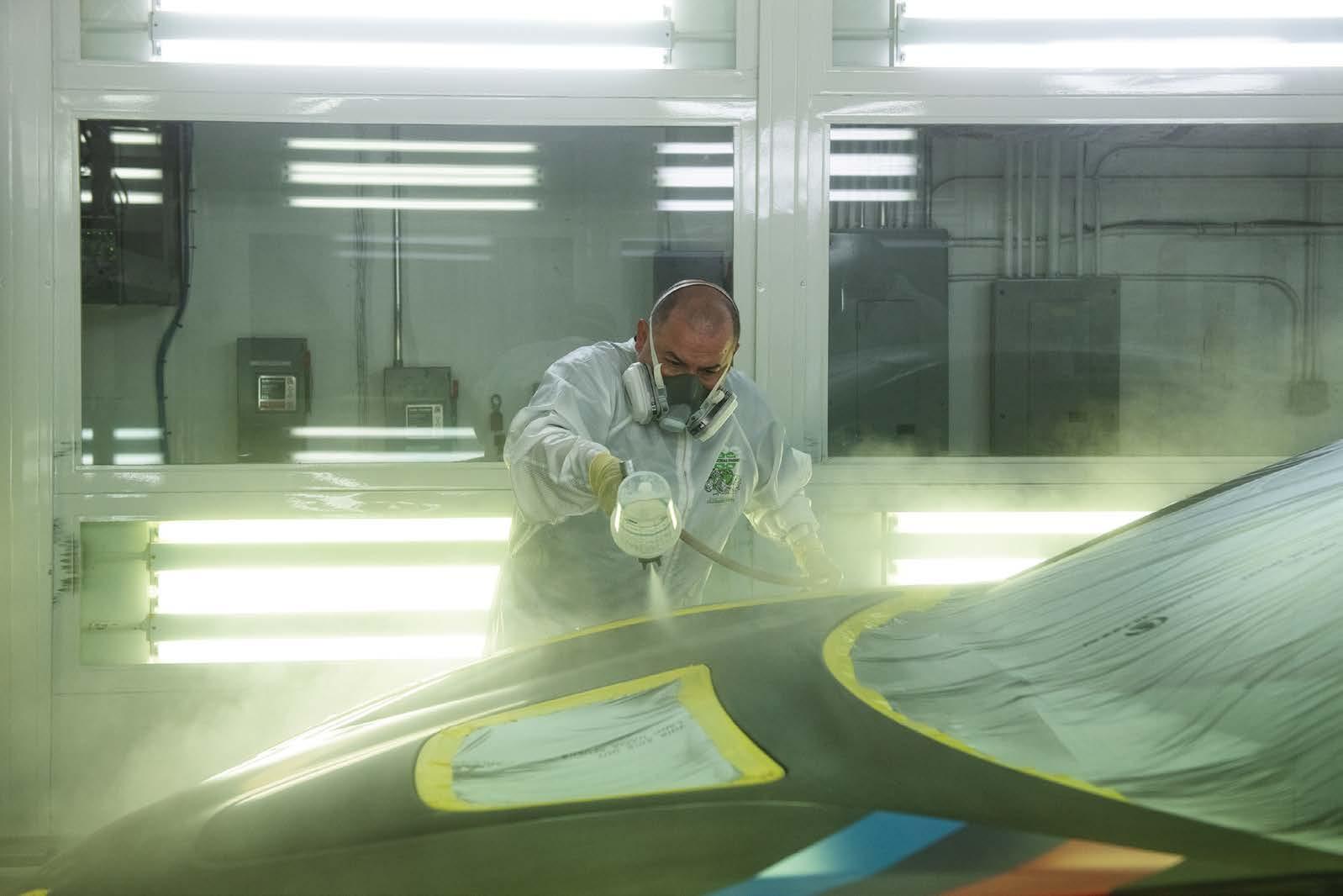




The U.S. Environmental Protection Agency (EPA) Administrator Michael Regan on April 12 announced proposed key gas car regulations that could promote EV adoption and save Americans money.
The new standards aim to be some of the most stringent ever, to further limit tailpipe pollution. These proposed changes are not final, which means there will likely be many modifications over the coming weeks and months before heading to a final approval stage.
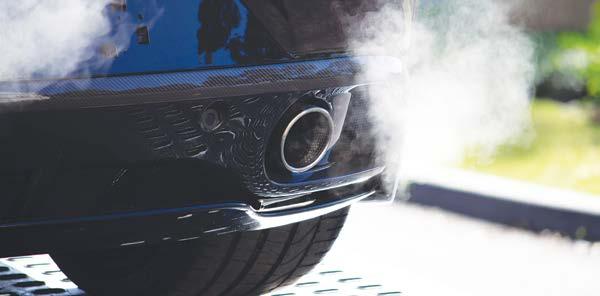
Under the new plan, electric cars, trucks and SUVs could comprise some 67% of all new light-duty passenger vehicle sales in the U.S. by 2032. Moreover, sales of medium-duty EVs could climb to an impressive 46% of all vehicles sold by 2032.
The standards would become stricter as time goes on. The end goal is to reach a U.S. fleetwide average of 82 grams per mile of carbon dioxide for light-duty vehicles and 275 grams for mediumduty vehicles by model year 2032.
The current rules aim for a fleetwide goal of 161 grams of carbon dioxide
REGIONAL NEWS
California Insurance Commissioner Ricardo Lara’s recent approval of a $263.7 million rate hike by California’s largest insurer, State Farm, marks the latest in a flurry of approvals of unjustified 2023 auto insurance rate hikes by the top six auto insurers, collectively totaling more than $1 billion, Consumer Watchdog said in a news release.
These companies insure approximately 48% of the state’s insured vehicles. The group said hardest hit by the rate hikes are lowincome workers who, under some auto insurers’ job-based rating plans approved by Lara, will pay up to 25% more than professionals with college degrees.
After months of inaction on the
REGIONAL NEWS
proposed rate hikes, Lara rushed to approve them over the objections of Consumer Watchdog, which challenged the proposed rates as unjustified under voter-approved Proposition 103.
According to Consumer Watchdog’s analysis of the rate filings, auto insurance companies are overstating projected losses and inflation trends, causing their proposed rates to be excessive. A recent study by Consumer Federation of America and Center for Justice and Democracy also concluded commercial insurers are misrepresenting their actual losses by large percentages.
“The commissioner needs to use
l CONTINUED ON PAGE 8
As proposed, the emissions regulations would be phased in from 2027 through 2032. The EPA expects such measures to reduce emissions by a minimum of 40% by 2030 and save car owners $12,000 over the course of ownership, so long as they own a car that complies with the new rules.
per mile by model year 2026, for both light- and medium-duty vehicles.
According to the EPA, the proposed standards could decrease emissions by as much as 56% compared to the existing standards.
It’s important to note the proposed EPA emissions standards do not
l CONTINUED ON PAGE 13
Detectives with the Fresno, CA, H.E.A.T. (Help Eliminate Auto Theft) Task Force arrested Christopher Michael Asher, 56, of Fresno, for allegedly running an auto broker scam.
On March 30, Asher was booked into the Fresno County Jail on numerous charges related to auto theft and forgery. His bail was set at $117,000. He has since posted bond and been released from jail with a court hearing scheduled for May 19.
l CONTINUED ON PAGE 4
Columnist Mike Anderson: Are You Giving Your Estimators the Time and Training Needed to Succeed?
Columnist Ed Attanasio: AirPro Diagnostics Helps Every Shop Repair All 550 of Today’s Models

Columnist Stacey Phillips: CCC Crash Course Report Shows Macrotrends Having Profound Impact
Columnist John Yoswick: Mike Anderson’s ‘Spartans’ Group Offers Shops Coaching, Comparison, Camaraderie


Mike
Are You Giving Your Estimators the Time and Training Needed to Succeed?
Andrews CIECAST Discusses How Collision Repairers Can ‘Move Upstream’ to Capture More
ProColor Collision opened its newest U.S. collision repair location in North Hollywood, CA.
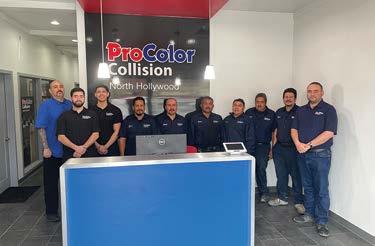
ProColor Collision North Hollywood is a full-service collision repair facility equipped to handle advanced collision repair services for drivers in the
Hollywood reflects owner-operator Pargev Adamyan’s commitment to providing superior quality collision repair services while offering exceptional customer service. According to Adamyan, customer satisfaction is the most invaluable consideration of operations.
“We offer the best customer service with 50 years of shop and insurance experience as we strive to do a better and cleaner job every time,” Adamyan said. “The shop recently acquired the I-CAR gold certification, further differentiating our services from competitors.”
provider in the evolving industry. He selected ProColor Collision as the perfect opportunity to take his business to the next level.
“After a long search of options, joining ProColor Collision proved to be the best choice with the most up-to-date technology, strong history and proven network support,” Adamyan said. “ProColor Collision is different from other brands because it offers resources and support in all aspects of the business, allowing us to focus on doing what we do best.”
Classic Collision, LLC, announced two new closings March 31—the acquisition of BJ’s Auto Theft & Collision in Commerce City, CO, and Irish Mike’s Collision in Orlando, FL.
For 30 years, BJ’s Auto Theft & Collision has been dedicated to returning customers vehicle to them in the best condition in the shortest time possible, while ensuring each customer has an exceptional experience.
greater Los Angeles area. Located at 6872 Lankershim Blvd., the 17,000-square-foot I-CAR Gold Class® facility recently upgraded to accommodate the latest stateof-the-art equipment to fulfill complex repairs that comply with OEM specifications.
ProColor Collision North
Detectives began this investigation in August 2022, after learning a Huntington Beach, CA, car dealer was searching for one of its vehicles, listed as stolen, in the Fresno area. HEAT detectives determined the Huntington Beach dealer originally sold this vehicle to Asher for $58,000.

Asher presented himself as the general manager of Artanis Automotive, located at 5494 E. Lamona Ave. in Fresno. Since Artanis had a valid licensed dealer number, the Huntington Beach dealer finalized the transaction by sending the vehicle to Fresno. However, the check Asher sent bounced when the dealer tried cashing it.
Detectives found the vehicle in Fresno and contacted the man driving it. He explained he bought the vehicle from Asher after giving him a down payment of $12,000. Asher helped him finance the remaining amount through a company called Anchored Finance. Detectives discovered this man and the finance company were victims of a scam Asher had constructed.
Due to being a previously convicted
With more than 20 years in the collision repair industry under his belt, Adamyan is keen to carry on his father’s 30-year legacy as an accomplished body man. Adamyan understands the importance of investing in proper collision repair training and the latest cutting-edge equipment to be a leading service
felon, Asher was not eligible to have a car dealer/broker license. However, he was able to obtain a license by forging documents, using the personal information of one of his acquaintances who had a clean record.
On March 30, detectives served a search warrant at Asher’s home in the 1000 block of E. Wathen Ave. in Fresno. There they collected evidence and arrested Asher.
Detectives have located additional victims who were scammed and investigations into those cases are taking place.
Law enforcement wants to inform the public of Asher’s illegal activity because there is a good chance there are more victims out there who have dealt with Asher and do not realize they have been taken advantage of or never filed a police report.
If you or someone you know are potential victims, contact the Sheriff’s Office at 559-600-3111 or Crime Stoppers at 559-498-7867, www.valleycrimestoppers.org. You will remain anonymous and may be eligible for a cash reward. Reference HEAT/CHP case number F146-41223.
Source: Fresno County Sheriff’s Office
Welcoming ProColor Collision North Hollywood into the network, Peter Polito, ProColor Collision’s general manager for the Western U.S., said, “ProColor Collision includes many inspired owners, such as Pargev, who understand the significance of representing an established global network and are dedicated to investing in superior efficiency and continuous education to achieve great success. We will continue to support their growth to help them achieve profitability.”
Source: ProColor Collision
Irish Mike’s Collision has been family owned and operated with a long-standing reputation for great work, affordable prices and trustworthy service.
“Both BJ’s Auto Theft & Collision and Irish Mike’s Collision have been high performers along with customer focused, and we look forward to welcoming them to the Classic family as we continue to expand our footprint across Colorado and Florida,” said Toan Nguyen , CEO of Classic Collision.
Source: Classic Collision, LLC



A shift in consumer driving behaviors since the pandemic, the rise of AI and labor shortages are some macroeconomic trends impacting the collision industry, according to the 28th edition of CCC Intelligent Solutions’ Crash Course Report, “ignite EXPERIENCE.” Meanwhile, there are advancements in vehicle technology, including advanced driver-assistance systems (ADAS) and electric vehicles (EVs), said Jason Verlen, CCC’s vice president, product marketing.
force looks like. These have clear, demonstrable and profound impacts on the claims repair ecosystem. The ramifications are deep, and from my perspective, I don’t think these issues are going anywhere anytime soon. There is generally less congestion on roadways since the pandemic and peak driving volume is occurring on different days and times. In the top 10 U.S. cities, miles traveled are roughly the same. It may even be up a bit, but downtown, it is 27% below the usual. This is due to more of a balance between hybrid work and going to the office, and more people living in rural areas and driving during
to complexity. When you look at a diagram of a front bumper from 10 years ago, it might have three or four obvious pieces. A front bumper today is double or triple that. It begins to add up when you have more parts to assemble and the growing need for diagnostic scans and performing a calibration to ensure everything is repaired correctly.
There are also more supplements. Roughly 60% of claims now have a supplement. If you look at data from 20 years ago, I believe it was 20%. As unbelievable as it sounds, about 5% of claims have four or more supplements. The cost of the supplements has almost doubled over the last five years from $500 to $900.
Another shift is the mechanical labor required. About 40% of claims on new vehicles require more expensive mechanical labor, which is double than five years ago.
With the amount of digital technology in new vehicles, we’re seeing a diagnostic scan included in the initial estimate. We wouldn’t have seen that years ago, but the computer systems in cars today need special tools to identify and diagnose damage.
Insurers and repair facilities are becoming more creative in figuring out how to handle the situation. We are seeing carriers being more flexible in hiring people who are not necessarily in the areas where they have their offices and working remotely. Repair shops, especially MSOs, are becoming more aggressive in setting up training programs to bring people on board.
Additionally, the rise of AI is making the claims process more efficient. The use of photo estimating, for example, has increased since the pandemic. About 27% of repairable vehicles go through the photo estimating process; indeed 150 carriers send CCC photos and approximately 100 apply AI to those photos. Over 14 million claims have used this technology since it was deployed.


One advantage of using AI is the superior process. If a carrier sends photos to a repair facility, it can apply AI to build an initial estimate and repair plan for the repair professional to review. AI also aids employees coming into the industry who have less experience than their predecessors.
“The macrotrends are having effects on how the industry functions,” said Verlen. “The industry is changing quickly.”
Subtitled “The Era of Experience,” Crash Course 2023 includes data from 260 million claims-related transactions, 50 billion miles of driving data, and millions of auto physical damage and auto bodily injury and personal injury protection (PIP)/medical payments (MedPay) casualty claims data and analysis. Verlen shared learnings from the report and the impact to the industry and consumers.
Q:
How are the findings different than prior years?
A: The transition is more profound in terms of what’s happening with repairs and claim times. This is not the usual market change. In addition, it’s what repair facilities and insurers are doing in the face of these shifts that readers will find interesting.
Q:
What are some macrotrends discovered?
A: The macrotrends include where people live, what cars they drive, how they drive and how technology like AI is changing their experience with vehicle ownership, insurance claims and repairs. Another macrotrend is what the labor
non-peak hours.
People are also driving differently. They are driving faster and are more distracted. This can be attributed to texting, as well as cannabis and alcohol use.
This affects Delta-V, which is the change in velocity between pre-collision and post-collision trajectories of a vehicle and indicates accidents are getting more severe.
New vehicles are not just bigger, but heavier and have more horsepower. We found people are driving more trucks with an average of more than 300 horsepower. The average internal combustion engine (ICE) vehicle has 1,500 semiconductors, whereas an EV is double that. When they are in accidents, there are definite ramifications.
Q:
What is taking place with repairs?
A: Costs continue to climb. Over the last five years, they have increased from an average of $3,000 per claim to $4,000. This is partly due to new technology. More parts and labor are on the average claim. Typically, parts consist of varying materials and many incorporate digital technology, which makes them more expensive to buy and repair.
The average number of parts on a claim five years ago was nine; in 2022, it was 13. It comes down
There are more situations where parts are replaced that would have
Q:How are these changes impacting consumers?
A:They affect customers because they affect cycle time. We have complicated vehicles that are expensive to repair. They require more steps, diagnostics and calibrations and there is less labor to do it. This impacts customers getting their cars into a repair shop. Many facilities have a waiting list of over a month. There’s no magic to shrinking those backlogs but there are steps shops can take, like getting more labor on board, getting more comfortable repairing these vehicles and transparency with customers.
been repaired previously due to the electronics inside. In some cases, there are more OEM parts with sophisticated electronics. That increases costs and repair time.
Q: How are these changes impacting labor?
A: The labor shortage, both for carriers and shops, is a huge challenge at the wrong time because of the dynamics of the vehicles themselves combined with how people drive.
There’s a big difference between a consumer waiting for a car that’s not functioning correctly and one that’s getting messages about the status of how the repair is progressing.
If a repair isn’t done transparently and there are delays and supplements, that’s frustrating for a customer. If the repair process is transparent, even in a challenging environment, a consumer is more likely to give the repair shop the benefit of the doubt.
To read the report, visit cccis.com/ crash-course.
Begins shipping April 11th – while supplies last
Leap into spring with the SATA BBQ promotion and get yourself a stylish, strong and functional BBQ apron as well as solid, innovative and multifunctional BBQ tongs in stainless steel. Whether at the next family gathering or at the camp site - with the SATA BBQ Kit you are perfectly set.
Beginning April 11, 2023, all SATA customers will get the limited edition BBQ Kit along with the purchase of SATAjet X 5500 (any technologies or versions) as a gift. Available only from your local authorized participating SATA dealers – only while supplies last.

his voter-enacted authority under Proposition 103 to protect California consumers from unnecessary rate increases and discriminatory overcharges, especially low-income workers hit hardest by the pandemic,” said Pamela Pressley, Consumer Watchdog senior attorney. “Under voter-enacted Prop 103, insurance companies have the burden to prove their requested rate hikes are justified. But by giving in to insurance company pressure to swiftly approve insurance companies’ requested rate hikes, the commissioner is short-circuiting the public scrutiny needed to ensure that excessive rates are not approved.
“These massive premiums increases have been approved even though most auto insurance companies have failed to fully repay their customers for windfall overcharges during the pandemic lockdown, when people dramatically reduced their driving and accidents, and insurance claims dropped,” Pressley said. “Consumer Watchdog has estimated that motorists are owed billions in additional refunds.”
The $1 billion in auto insurance rate hikes approved by Lara over the last few months, which will take effect in 2023, include:
State Farm
Under State Farm’s approved $263.7 million overall 6.9% rate hike, 3.7 million policyholders face an average rate increase of $71 per policyholder. According to Consumer Watchdog’s analysis finding the company overstated its projected losses, this increase was more than double the amount that should have been approved, resulting in $136.8 million in overcharges to consumers.
Auto Club gives a premium discount. These grocery clerks, hotel workers, janitors, home health care aides and other drivers without white-collar jobs will be surcharged, paying up to $167 more in annual premiums per policy than drivers in one of Auto Club’s preferred occupation groups.
Under Mercury’s approved $132 million overall 6.9% rate hike, 1.6 million insured vehicles will face an average increase of $80 per insured vehicle. Under Mercury’s five-tiered rating system based on education and occupation, most workingclass policyholders—from waiters to cashiers, construction workers to call center operators—will pay up to about 20% more than drivers with professional occupations and advanced degrees such as engineers with a bachelor’s degree or higher education level.
The Department prematurely approved Mercury’s and its subsidiary Cal Auto’s rate filings over Consumer Watchdog’s objections to the companies’ discriminatory jobbased surcharges and inflated loss projections and without allowing Consumer Watchdog to complete its full analysis.
low-income workers up to $130 higher base rates for a six-month policy than professionals with advanced degrees. Consumer Watchdog wrote to the commissioner in December calling on him to reject the proposed rate changes.
Allstate
Under Allstate’s approved $165 million overall 6.9% rate hike, more than 900,000 policyholders will face an average $167 annual premium increase. Consumer Watchdog wrote to the commissioner in September urging him to reject Allstate’s rate proposal and job-based rating system.
Allstate filed for another 6.9% rate hike in January that is still pending approval. That filing removed its jobbased discounts for the first time since they were approved by the department 10 years ago.
In March, Consumer Watchdog filed a petition for a hearing on Infinity’s auto rate filings. Under its rate application for the company’s “RSVP” auto program, Infinity is requesting a $168.7 million overall 34% rate hike impacting 467,104 insured vehicles with an average rate increase of $360 per vehicle. For its “Special” auto program, the company is seeking a $130 million overall 26.1% rate hike impacting 522,237 insured vehicles for an average rate increase of $250
per vehicle. Among other issues, Consumer Watchdog’s petition alleges that the company is overstating its expected losses, resulting in an inflated rate request.

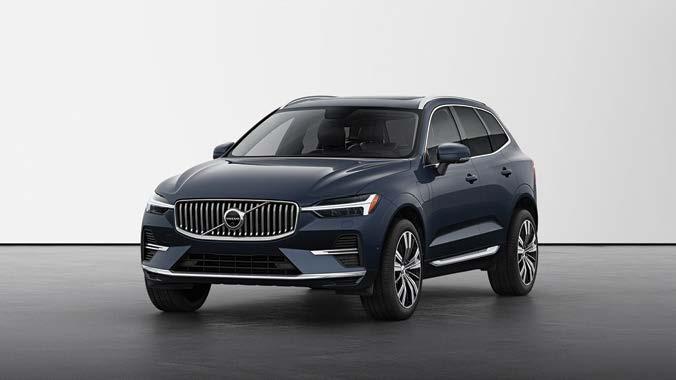
Voter-approved Proposition 103 requires insurers open their books and justify their rates in a public process in which consumer representatives have the right to access information filed with the commissioner and actively participate. If an insurance company seeks a rate increase that exceeds 7%, and the application is challenged by the public, the department must hold a hearing. Companies frequently file serial rate increase requests that fall just below the 7% threshold in order to avoid a public hearing.
In a 2019 study of the nation’s insurance laws, the Washington, D.C.,-based Consumer Federation of America called Proposition 103 “the best in the nation” and calculated it had saved Californians $153 billion on their auto insurance premiums alone, while allowing insurance companies to earn fair profits.
Prop 103 also requires auto insurance premiums be based primarily on three mandatory
l CONTINUED ON PAGE 12
Interinsurance
Under the Auto Club’s approved $202 million overall 6.9% increase, 1.44 million policyholders, who collectively own 2.68 million vehicles insured by the company, face an average annual premium increase of $75 per insured vehicle ($140 per policy). According to Consumer Watchdog’s analysis finding the company overstated its projected losses, this increase was more than seven times the amount that should have been approved, resulting in $175.6 million in overcharges to consumers.
The worst of Auto Club’s rate increase will fall on low-income drivers who don’t have one of the professional occupations for which
Under GEICO’s approved $268 million overall 6.9% rate hike, 2.1 million policyholders will face an average $125 annual premium increase. Drivers working in fields like custodial, construction or food service will pay 25% higher premiums than drivers in GEICO’s preferred “professional” occupations, including lobbyists, architects and financial analysts. They will pay almost 11% more than engineers, auditors and judges. GEICO filed for another 6.9% rate hike last month that is still pending approval.
Contrary to Prop 103 and its own long-standing procedures, the department failed to require GEICO to turn over most of the information requested by Consumer Watchdog, which was necessary for its actuary to fully evaluate the proposed rate increase. Consumer Watchdog’s preliminary analysis as alleged in its petition showed that the company was overstating its projected losses, resulting in an inflated rate request.
Under Farmers’ approved $167.8 million overall 6.9% rate hike, 1.7 million policyholders will face average increases of $98 per policyholder. Additionally, this approval allows Farmers’ to continue its discriminatory three-tiered rating system charging
ONLY ONE THING LASTS LONGER THAN OUR COATINGS. OUR






As the world leader in coatings, our long-term commitment to our customers is reflected in the numbers.

3,500,000+ COLOR FORMULA GLOBAL DATABASE
38,000+ NORTH AMERICAN CUSTOMERS USING PPG REFINISH PAINT

15,000+ TECHNICIANS TRAINED EACH YEAR
10,000+ SHOPS USING MVP BUSINESS TEACHINGS
2,500+ U.S. AND CANADIAN DISTRIBUTORS
120+ YEARS OF INNOVATION IN REFINISH COATINGS
1 COMPANY DELIVERS ALL OF THIS
Bottom line? As long as there are vehicles to paint, PPG will be there to help you paint them.
www.ppgrefinish.com

Recently, I got a call from Mike Schaffer, collision manager at Selman Collision Center, a GM aluminum-certified shop in Orange, CA, needing help welding an aluminum body Cadillac CT6. He thought his welder was the problem. I told him I could be there in two days, and he should consider a review course on aluminum welding at the same time.
When I arrived, the first thing he showed me was the front rail section that was removed from the vehicle. It had practice welds on one side, and they were horrible. I asked Schaffer if they had welded on the new part and he said not yet.

aluminum.
Remember, Series 6 aluminum has both magnesium and silicon. You can use Series 4 welding wire (silicon) and Series 5 wire (magnesium) on Series 6 aluminum. Series 4 wire is weaker and needs less amperage to weld, making it easier to weld thinner aluminum, such as a crack in a 1 mm fender.
Series 5 wire will weld Series 5 aluminum, but Series 4 wire will not. There is very little to no penetration of Series 4 wire into Series 5 aluminum.
The article title is advice I also need to take. I have been teaching aluminum welding for I-CAR for nearly two decades. When I first started, my instructor said the test had to be conducted with Series 5 (5356) wire, not Series 4 (4043), because the Series 4 wire will not penetrate Series 5 aluminum. I was also told Series 5 wire would not work on Series 4 cast aluminum. As I previously wrote, my rule of thumb is not entirely correct.
To write this article, I read several articles on aluminum welding. Series 5 wire can be used on Series 4 cast aluminum parts. 5554 wire is stronger than 4043, but tends to produce porosity and cracks when used to weld aluminum castings. 4043 is better for castings because the silicon content makes it a closer match for most aluminum castings. Furthermore, some OEMs recommend Series 4 wire for welding to cast aluminum.
said the new cast rail end is welded to the extruded rail—the only information on the procedure. To learn the correct wire, you have to print out the other two documents, aluminum and the part material and part description.
The rail end cap was cast and the rail end cap was extruded (Series 7) and 5554 wire was called out. I knew Series 7 parts are used on today’s vehicles, such as bumper reinforcement and intrusion beams, but I wasn’t familiar with it being used or welded before reading the info from GM.
Aluminum oxide is a high temperature compound that forms on bare aluminum in presence on water and oxygen. It needs to be removed during and/or prior to welding. If it is not cleaned, the aluminum oxide will sink into the molten metal and form inclusions with weld. This will lead to porosities and/or cracks.

Galvanic corrosion refers to corrosion damage that occurs when electrochemically dissimilar metals (bare steel and bare aluminum) come in contact with each other in the presence of moisture and oxygen. The aluminum will corrode and there is no way to stop it.

cleaner with improved shielding gas coverage and reduced weld bead contamination.
Finally, what is the recommended standoff distance (distance from the nozzle to the work surface) when welding aluminum?
The distance from the nozzle to the work surface is 12 to 13 mm with a gun angle of 80 degrees from perpendicular. There should be no side to side movement when welding aluminum.
Going back to the welding discussion with the four techs and Schaffer—who has participated in every I-CAR class I have conducted at the shop so he would have the knowledge and skills his techs have— we welded the bead on the Series 7 extrusion with 5554 wire. These were the results with no practice.
I checked the welder, and it was set for 5554 wire, 1.2 mm diameter and pulsed. I checked the tension on the rollers and it was right on. I took out a couple of 5 Series coupons and welded a fillet/overlap joint. Their Pro Spot SP5-DP worked great.
I knew what the problem was instantly, but before I explain, let me give you the scenario.
The end cap was cast aluminum (Series 4), the rail was extrusion (Series 7) and the wire was 5554 (Series 5).
The major alloying element in Series 4 is silicon, Series 5 is magnesium, Series 6 is a combination of silicon and magnesium, and Series 7 is alloyed with zinc.
What are the four major welding wire numbers found in most body shops? 4043, 4145, 5554 and 5356.
The rule of thumb is this: your welding wire has to have the same major alloying element(s) as what is in the base metal. Note: Series 5 wire is recommended for Series 7
I want to change my rule of thumb to: “Your welding wire has to have the same major alloying element(s) as what is in the base metal when welding Series 5 and 6 wire. When welding Series 4 and 7, refer to OEM procedures.”
I want to move on to OEM procedures.
I am always stressing first and foremost, print out the repair procedures for the repair task, including the library. Schaffer sent three documents: Aluminum, Structural Identification and Front Rail Replacement (Non-Hybrid). The repair and replacement procedures
The improper use of steel cleaning products, such as steel wool or a steel wire brush on aluminum or magnesium, can force small pieces of steel into the metal being cleaned, causing corrosion. Stainless steel is known for its high resistance to corrosion because of its high chromium content combined with nickel. It also has very low carbon content, whereas mild steel is higher in carbon content, which facilitates galvanic corrosion. After using a stainless steel brush to clean the aluminum, wipe with acetone, 99% isopropyl alcohol or a good wax and grease remover. Do not use lacquer thinner.
Why is “pushing the puddle” the only recommended direction for welding aluminum?
When the aluminum oxide forms on the surface, it also migrates below the surface. The heat from the welding process causes the aluminum oxide below the surface to rise into the welding site. By using the push technique—also known as an arc cleaning action—the 100% argon gas acts as a snow plow to push the oxides out of the way and to the sides of the weld site.
Note: The welding nozzle for aluminum is usually larger than a steel MIG/braze nozzle to accommodate the increased gas flow (25 to 45 CFH depending on the gun and nozzle.) Pushing the puddle, the weld will be
On the other hand, a short bead happened when the first tech forgot to measure the extrusion’s thickness and set the welder for it. Ladies and gentlemen, this is why we need to continue to train on a regular basis.
“I want to change my rule of thumb to: Your welding wire has to have the same major alloying element(s) as what is in the base metal when welding Series 5 and 6 wire. When welding Series 4 and 7, refer to OEM procedures.”
TOBY CHESS
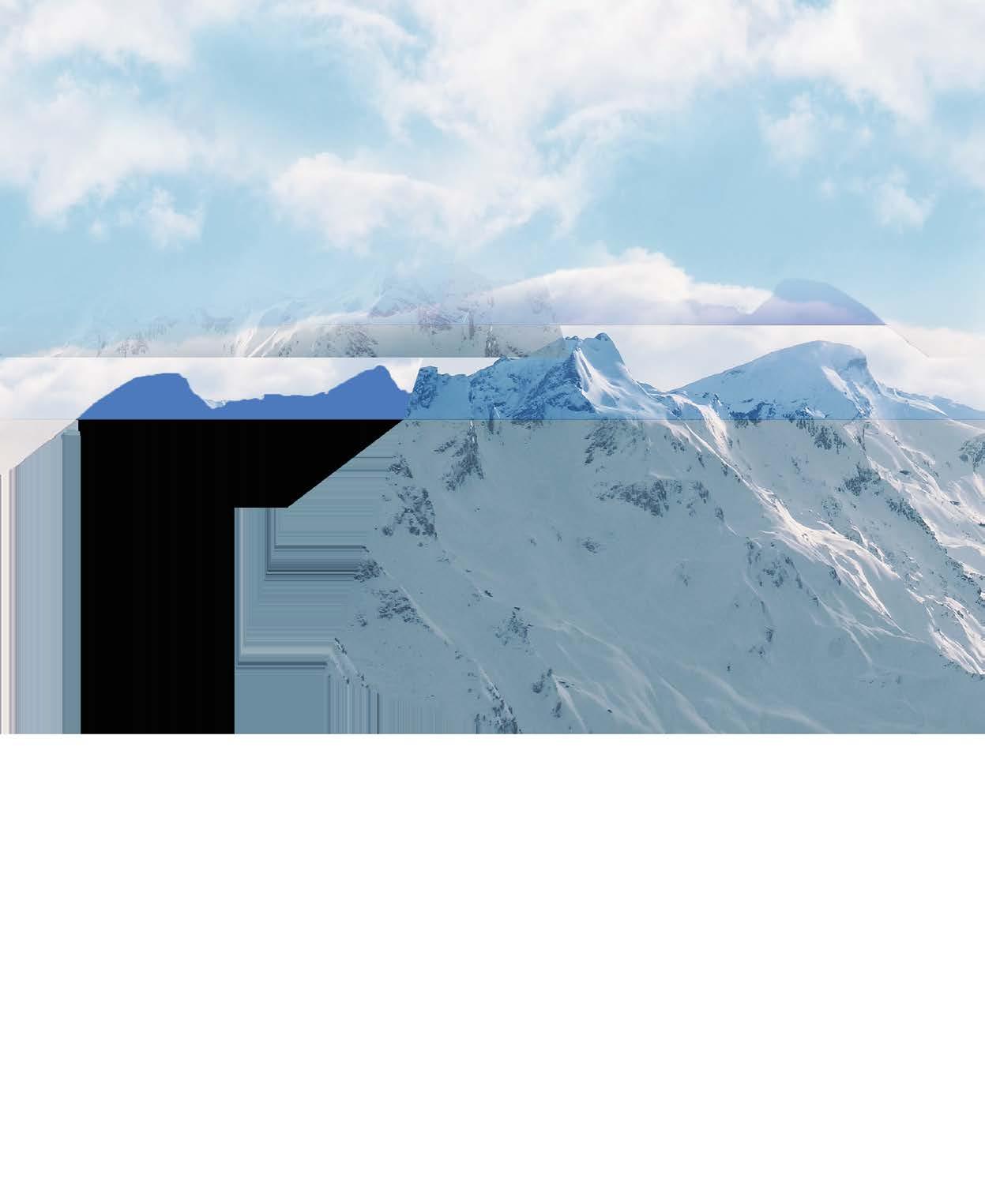






factors—driving safety record, annual mileage and years driving experience—and prohibits excessive and unfairly discriminatory rates. The commissioner can adopt other optional rating factors by regulation, but occupation has never been adopted as a rating factor.
Consumer Watchdog and 10 community and civil rights organizations challenged auto insurers’ illegal and discriminatory use of job and education to set rates in February 2019. In September 2019, a Department of Insurance investigation confirmed those concerns, finding “wide socioeconomic disparities” created by insurance companies surcharging California drivers based on nothing more than their occupation or educational status. In December 2019, the department proposed rules to address this unfair discrimination. However, more than three years later, those rules have not yet been adopted by the commissioner.
Source: Consumer Watchdog

EVgo Inc. on April 4 announced it has been selected for proposed awards of $6.6 million from the California Energy Commission’s (CEC) California Electric Vehicle Infrastructure Project (CALeVIP) 2.0 program.
The funding is designed to aid the deployment of fast charging
deploying high-power 350kW chargers at each of the locations supported through this program as part of the company’s ongoing commitment to delivering a bestin-class charging experience.
infrastructure in the central and eastern regions of California through the Golden State Priority Project (GSPP), which provides rebates for the installation of DC fast chargers capable of at least 150kW, focusing exclusively on disadvantaged community or lowincome community census tracts.
With the rebate, EVgo will be
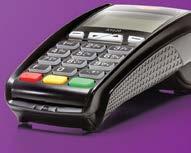
“EVgo recognizes the ongoing importance of public-private partnerships to enable rapid EV adoption, and the California Energy Commission is a true leader in incenting market acceleration and private sector investment through programs like CALeVIP 2.0,” said Jonathan Levy, chief commercial officer at EVgo. “EVgo and the CEC share a commitment to Electric for All that includes ensuring fast charging infrastructure is distributed equitably and installed in communities across demographics and geographies.”
Launched in January, the GSPP was the first project available through CALeVIP 2.0 with a focus on equity and swift charger

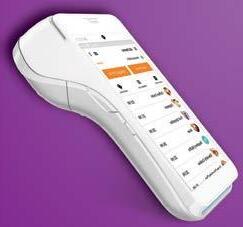
installation. With the proposed funding, EVgo will build more than 100 DC fast charging stalls across 17 locations in central and eastern California, including Fresno, Hayward, Manteca, El Cerrito, Antioch and San Jose.
More than 40% of EVgo’s existing fast charging network in California is located in disadvantaged and/or low-income census tracts, and with these 17 fast charging projects, EVgo can bring more convenient and affordable charging solutions to neighborhoods that will benefit most from the electrification of transportation.
In addition to its focus on equity, GSPP incorporates a number of public funding best practices, including a focus on higher-power equipment and project readiness, prioritizing projects likely to be able to deliver near-term results for Californians.
Source: EVgo

Earthling Automotive, formerly known as Luscious Garage, opened its doors to provide expert electric vehicle (EV) and hybrid repair services in the San Francisco Bay Area.
Under the leadership of CEO Carolyn Coquillette, Earthling Automotive will serve the growing EV market, setting a new standard for the independent automotive repair industry.
“Vehicle innovation, consumer adaptation, and California’s push for EV adoption demanded that we rethink our aftermarket service concept from the ground up,” said Coquillette. “Earthling Automotive proudly offers independent EV and hybrid service at a fair price, based on 16 years of experience in the Bay Area. Our mission is to lead the aftermarket’s adaptation to hybrid and EV platforms.”
Coquillette, who started Luscious Garage in 2007 as a hybrid-dedicated repair shop, and is also the founder and CEO of the

SaaS auto repair software ShopWare, saw the need to transition her repair business to meet the increasing demand for EV repair in San Francisco. Earthling Automotive has been built from the ground up with Tesla in mind, and is equipped with the expert technicians, tools and technologies to fill the burgeoning need for convenient, personalized and affordable service for all Tesla makes and models, as well as other EVs.
Luscious Garage closed as a repair shop at 9th Street on April 3, but the facility will continue operations as Earthling Automotive’s new training facility, offering hands-on EV training to technicians and instructors in the San Francisco Bay Area and beyond. Tesla and Prius platforms underpin the initial EV and hybrid classes, already open for registration at earthlingauto. com/training
Source: Earthling Automotive
have a specific EV requirement, and they don’t ban gas-powered vehicles. Instead, automakers can meet the mandates with whichever vehicles they see fit.
That said, the standards would almost certainly boost EV production and sales since manufacturers would likely need to sell an increasing number of electric cars in order to comply with the standards. Many automakers have already invested heavily in fully electric cars, so it simply makes sense they’ll continue on that path.
The proposed rules, labeled by the organization as Phase 3, also include guidance for heavyduty vehicles, meaning there will be stricter emissions regulations



put into place for school buses, delivery trucks, construction-related vehicles, etc. The goal is for 50% of new buses and 25% of new heavy truck sales to be fully electric by 2032.
If all goes as planned, the U.S. could save trillions of dollars on fuel costs and health care, while eliminating around 10 billion tons of emissions. As a result of the new mandates, at least 50% of all new vehicles sold in the U.S. by 2030 should be zero-emission vehicles, though the number stands to be as much as 10% higher. In 2022, only 6% of new U.S. vehicle sales were fully electric cars.
Finally, the EPA is also working to set specific rules about minimum warranties for electric car batteries, as well as making built-in battery health monitors required in new cars.
Following the delivery of Lucid Motors’s first customer vehicle model in late 2021—the Lucid Air—the luxury electric vehicle (EV) manufacturer has ramped up production. By yearend 2022, Jake Rodenroth, Lucid’s North American body repair program operations manager, said it was “all hands on deck.” This allowed Rodenroth to work with the service and sales teams, onboard customers and deliver vehicles.
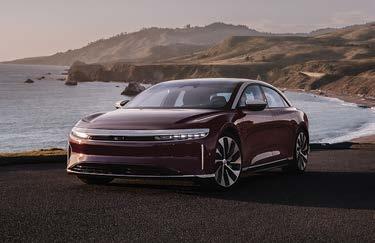
Rodenroth shared information about Lucid Motors’ vehicles during an AkzoNobel North American Performance Group event in February.
Founded in 2007, Lucid is headquartered in Newark, CA. The company’s debut product, the Lucid Air, was named 2022 MotorTrend Car of the Year, the first time any vehicle
To achieve Lucid’s range and performance, Lucid’s aerodynamics team worked with its design and engineering counterparts to prioritize aero efficiency.
Rodenroth discussed Lucid’s aerodynamic air-curtain technology, which includes a small air intake (grill), a vortex system, a side air curtain and a small headlight aperture that helps with headlight cooling.
The bottom of the car is flat and designed to have a smooth surface to improve aerodynamics.

“That matters when you’re trying to jack up the car,” said Rodenroth. “When accessing the drive unit, numerous trim pieces will need to be removed.”
Lucid vehicles have a 12v powerup harness behind the passenger rear wheel liner, in the event power to the vehicle is lost. This enables the trunk, “frunk” and doors to be opened with key fobs present.
The vehicle’s advanced technology was engineered and designed in-house. This includes a speed form taillight and intelligent Micro Lens Array headlamps. The bright and precise lighting system has 9,740 lenses per pair of headlights.
Lucid provides over-theair (OTA) software updates offering vehicle owners new features.
it,” he said. “It’s a value-add to your facility.”
During a repair, the Lucid Air body structure doesn’t permit welding; instead, a rivet bonding process is used, requiring the correct tooling, training and adhesive.
Regarding special tooling, Lucid uses 3D printers to print service tooling for its Lucid Certified Body Repair Network shops.
“We try to think about the technician working on this car,” shared Rodenroth.
DreamDrive is Lucid’s advanced driver-assistance system (ADAS) with 32 multi-model sensors and 14 cameras. The combination of sensors and mounting locations means shops will have to pay attention to Lucid service resources and capture and perform all necessary calibrations.
“The car triggers a lot of calibrations but is fairly forgiving as far as calibration goes,” noted Rodenroth.
The Snap-on TruPoint System with Lucid diagnostic and specific targets are used for static calibrations and the maximum space requirement is approximately 15 feet wide by 30 feet long.
As repair shops set up charging stations, Rodenroth recommends at least a level 2 charger.
minutes.
Rodenroth said Lucid’s Wunderbox provides the fastest charging in the industry. Fully integrated and compatible with nearly all public charging stations, the battery management system is capable of bidirectional charging.
“In the event of a power outage, a fully-charged Lucid Air can keep your home powered for days due to the bidirectional charging capabilities of the Wunderbox,” he said.
Currently, about 74 body shops are in Lucid’s Body Repair Network program.
“We’re scaling that with production,” said Rodenroth. “As we fill orders, we look where those cars are going and what our coverage looks like.”
With aggressive production goals, Rodenroth said the OEM wants to add additional shops to the network that can be trusted to repair these vehicles properly.
“We are fiercely protective of our certified network,” said Rodenroth. “I hold our shops to a standard; I also protect them.”
His call to action to shops is to look at what they are doing to change their business and inspire employees to take training and be great at what they do.
manufacturer received the award with its inaugural vehicle.
“It was a really big achievement for our first product the first year of launch,” said Rodenroth.
The Air can be reserved and ordered in retail shopping centers and online. The model currently has four trim lines. They include the Air Pure with 480 hp and a 410-mile range starting at $87,400; the Air Touring with 620 hp and a 425-mile range from $107,400; and the Grand Touring with up to 1,050 hp and a 516-mile range from $138,000. The Sapphire and Stealth packages will follow.
The EVs have an eight-year warranty, which includes 100,000 miles on the powertrain and battery.
Lucid’s Gravity SUV is expected to be released in 2024.
Fast like a sports car but with a large storage capacity, Rodenroth said the EVs were designed to offer several features using one platform, the Lucid Electric Advanced Platform (Leap). The integrated drive unit comprises an electric motor, inverter and transmission weighing only 163 pounds and capable of 670 hp each.
For repairers who have never driven an EV, Rodenroth highly suggests renting one.
“It’s a big learning curve that even some of the legacy OEMs are struggling with because they’re so different than gas cars, in regard to servicing and selling them,” he noted.
Rodenroth said technicians must learn how these vehicles and their charging systems operate to do a proper repair.
“It’s not enough to go through the training to learn how to take the cars apart and put them back together,” he said. “You also need to understand how they work with the owner.”
This includes using the mobile app and the connectivity vehicle owners have with the ability to check their vehicles, even if they aren’t in their possession.
For repairers, Rodenroth said EVs bring additional opportunities for added services to customers. Many have a large, painted frontal area, which means there will likely be more stone chips.
“If you’re not in the paint protection film business, I highly recommend
“Level 1 is a very slow charging process with only 7.2 miles of range per hour of charge,” he explained. “Level 2 is faster and has 43.2 driving miles per hour of charging.”
If a station is installed in a shop’s parking lot, Rodenroth suggests
Earlier this year, the company launched the Lucid Air Structural Certification hands-on course to help shops prepare for the launch of the Air. About 76% of shops are expected to be certified by year-end. “There’s no better way to learn the car than going through this,” said Rodenroth.
adding it to the PlugShare EV charging station mobile app to attract EV owners to their business.
“In that app, people take pictures of themselves charging their cars so you can see the environment,” he said.
Lucid offers an 80-amp charger— the Lucid Connected Home Charging Station—with 86.4 miles per hour of charging. Level 3 charging (DC) has 900 V+ architecture, enabling the Lucid Air to charge 300 miles in 20
Lucid also offers Mechanical, Electrical and Trim Level 2 Certification (MET) courses facilitated by the Lucid service training team. The course provides technicians a look at Lucid Air systems, including ADAS and calibration, closures, subframe and drive units, high-voltage and 12V systems, interior trim, supplemental restraint system and wheels/tires and TPMS system.
Plans are in place for an advanced diagnostic class and an aluminum cosmetic repair course.
For information about Lucid Motors, visit www.lucidmotors.com
To join Lucid’s Certified Body Repair Program, visit techinfo. lucidmotors.com
P265/70R17 P265/70R17 REAR SPARE
FRONTGAWR: 2735LB AT
REARGAWR: 3325LB 1508KG P235/70R16SL 16X7.0J GVWR: 5880LB/2667KG WITHTIRESRIMS PSI COLD
240 kPa/35 1240KG P235/70R16SL 16X7.0J
AT 205 kPa/30
THISVEHICLECONFORMSTOALLAPPLICABLEFEDERALMOTOR VEHICLESAFETY STANDARDSIN EFFECTON THEDATEOF MANUFACTURESHOWNABOVE.
01/03 VIN:TYPE:00000000000000000 MPV
WITHTIRESRIMS PSICOLD F0085T0183 UA
VEHICLEMFD.BYFORDMOTORCO.INU.S.A. RC: DS0: WB BRK INTTR TP/PS R AXLE TR SPR 114 4 GP K 45 V DB F05 UTC
SRSSIDEAIRBAG COUSSINGONFLABLELATÉRAL
13 3U51B
POURÉVITERDESBLESSURES
GRAVESOUMORTELLES: •Nevousappuyezpascontrelaporte. •N’utilizezpasuncouvre-siège quipeutbloquerledéploiementdu Voircoussingonflablelatéral.lemanuelduconducteurpour deplusamplesrenseignements.
CONTROLVEHICLEEMISSIONINFORMATION
Fuel: Gasoline
Conformstoregulations: 2015
Californiaclass/stds: PC/ULEVqualified

U.S.EPAclass/stds: LDV/TIER2
Group: FGMXV01.80111.2L
TIREANDLOADINGINFORMATION
Thecombinedweightofoccupantsandcargoshouldneverexceed352kgor776lbs.
SEEOWNER’S MANUALFOR ADDITIONAL INFORMATION
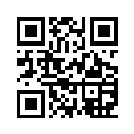

Conformstoregulations:
VEHICLEEMISSIONCONTROLINFORMATION
Conformstoregulations:2016MY Not for sale in states with California emissions standards.
U.S.EPA:T2B4 LDV
FEDOBDII
TWC/HO2S/WR-HO2S/CAC/TC/DFI
2.3L-Group:GFMXV02.3VJW Evap:GFMXR0125NBV
Fuel:Gasoline ABZ
Noadjustmentsneeded.
VEHICLEEMISSIONCONTROLINFORMATION
U.S.EPA:T2B4 LDV
2016MY
California: Not for sale in states with California emissions standards.
FEDOBDII
TWC/HO2S/WR-HO2S/CAC/TC/DFI
2.3L-Group:GFMXV02.3VJW
Evap:GFMXR0125NBV
Evap:SFI/HO2S/TWCFGMXR0095805 , OBD:II 00000000 FRONT REAR SPARE 215/55R1697H215/55R1697HT125/85R1699 SEATINGCAPACITY TOTAL 4 FRONT 2 REAR 2
Noadjustmentsneeded.
VEHICLE MFD .BY: TOYOTA MOTOR MANUFACTURING, GVWR 4233LB GAWR FR 2668LB RR 2668LB THIS VEHICLE CONFORMS TO ALL APPLICABLE FEDERAL MOTOR VEHICLE SAFETY , BUMPER , AND THEFT PREVENTION STANDARDS IN EFFECT ON THE DATE OF MANUFACTURE SHOWN ABOVE . PASS. CAR C⁄ TR : 4Q2 ⁄ LA43 ACV30L--CEPGKA A ⁄TM: --01A ⁄ U241E MADE IN U.S.A. 08270 00000000000000000 KENTUCKY, INC. 02⁄ 04 STK A AA5 To Visit Our Website SCAN HERE FOR ADDITIONAL INFORMATION ABOUT AUTO DATA LABELS: visit our website at www.AutoDataLabels.com email us at labels@AutoDataLabels.com or call us at (631) 667-2382 4 EASY WAYS TO ORDER LABELS! DON’T RISK LOSING YOUR VEHICLES IDENTITY! ORDER REPLACEMENT VIN LABELS TODAY! Federal Safety Certification (VIN) Label C /TR : 218 ⁄ FA2 0 AXAA54L– ANZMBA A/TM : -01A ⁄U B 80F MADE IN U.S.A. 512 THIS VEHICLE CONFORMS TO ALL APPLICABLE FEDERAL MOTOR VEHICLE SAFE TY AND THEF T PREVENTION STANDARDS IN EFFECT ON THE DATE OF MANUFACTURE SHOWN ABOVE. 11 /18 VEHICLE MFD. BY: TOYOTA MOTOR CORPORATION GVWR: 2090KG ( 4610LB ) GAWR: FRT. 1150KG ( 2535LB ) WITH 225/65R17 TIRES, 17X7J RIMS RR. 1150KG ( 2535LB ) WITH 225/65R17 TIRES, 17X7J RIMS E Replacement label: Not from Toyota JTMP1RFV1KD000000 MPV Contact Us : Contact your LKQ/Keystone Local Sales Rep Upload your photos to the Website: www.AutoDataLabels.com Email your photos: Labels@AutoDataLabels.com Use the App: Download the ADL App And Upload your Photos VIN labels contain vehicle-specific safety information. This information is critical for safe operation and proper repair procedures. • Tire Pressure • Gross Vehicle Weight (GVW) • Paint and Trim Codes • Spare Tire Size
The Caliber family of brands kicked off its 12th Annual Restoring You™ Food Drive on April 10. The recurring campaign is part of Caliber’s Restoring You platform and focuses on combatting childhood food insecurity across the country.
According to Feeding America, about 22 million children in the U.S. rely on daily free or reduced-price school lunches for their main meal. During the summer, students lose access to that meal. Caliber is working with more than 125 food bank partners nationwide to support their summer feeding programs.
Non-perishable food and monetary donations can be made at any Caliber location by May 26. Monetary donations can also be made online at www.caliber.com/why-caliber/ restoring-you/food-drive
To help stretch donations, the Caliber Foundation will donate an additional 25 cents for every dollar raised.

PPG on March 29 announced it has honored Wyoming Automotive of Casper, WY, as its Automotive Refinish 2022 Platinum Distributor of the Year.
of Excellence awards ceremony in February.
The annual award recognizes distributors with exceptional service, loyalty, product knowledge and support as part of the PPG PLATINUM DISTRIBUTOR™ program.

Natalie Scott, PPG director, PPG Platinum Distributor program, Automotive Refinish, U.S. and Canada, presented the award to Wyoming Automotive owner Eric Robinson during PPG’s annual Platinum Distributor Celebration
“Platinum Distributor of the Year recipients exemplify what it means to deliver quality products and outstanding service to automotive refinish customers,” said Scott. “We selected Wyoming Automotive as this year’s honoree because it has a proven track record of superior customer service and deep technical product expertise. Congratulations to the Wyoming Automotive team for a job well done.”
Wyoming Automotive has served Casper and the surrounding area for more than 100 years. Today, Robinson and Ben Meyer own the business, which has been a refinish distributor since 1962. It became a PPG Platinum distributor in 1995 and a PPG Platinum Plus distributor in January 2005. Wyoming Automotive offers a full line of PPG automotive refinish and commercial coatings products.
“We are overwhelmed to be named 2022 Platinum Distributor of the Year and thank PPG for its ongoing support,” said Robinson. “The award is a testament to our team members who provide unwavering support to help our customers succeed and navigate ongoing industry challenges.”
The PPG Platinum Distributor program started as a loyalty and support initiative for PPG single-line distributors, aiming to provide outstanding performance, service and benefits to PPG automotive refinish customers. The program delivers competitive advantages to participants by aligning PPG’s technology, training and customer support with entrepreneurship, customer awareness, local market knowledge and the service capability of independent distributors.
To learn more about PPG automotive refinish and the PPG Platinum Distributor program, call 800-647-6050 or visit ppgrefinish. com.
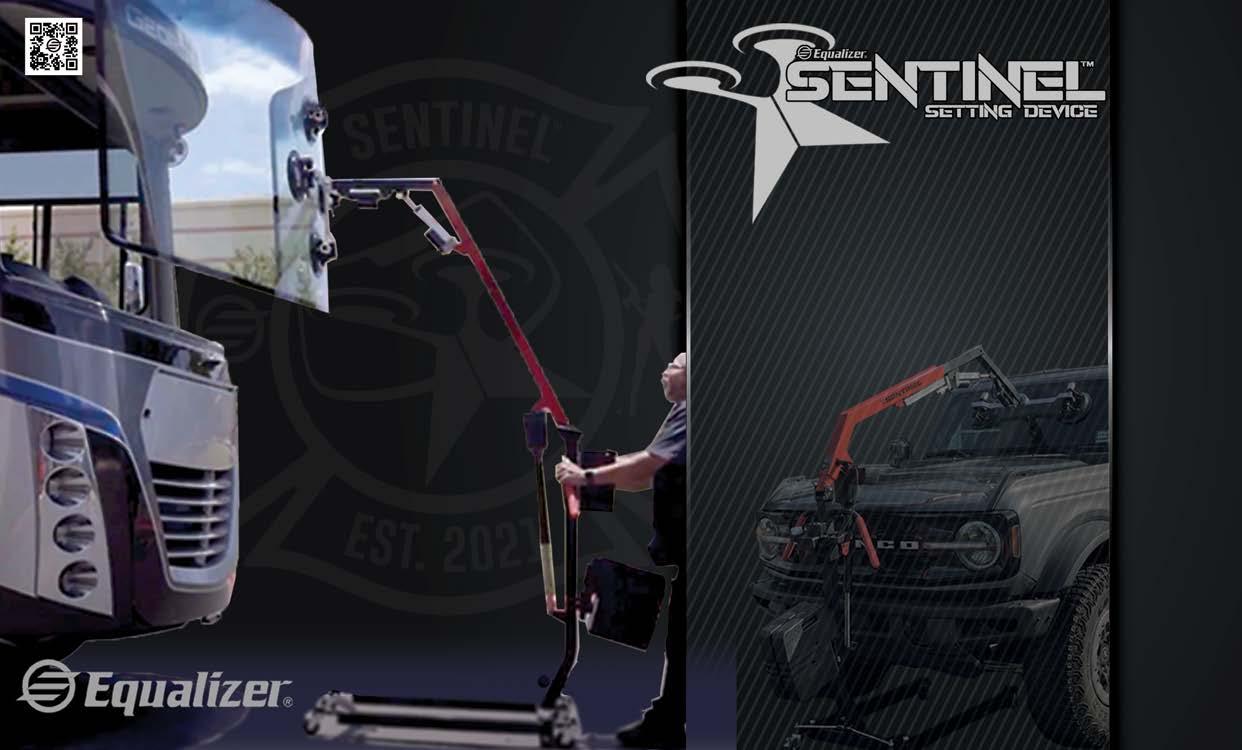
Mike Harris of Holstein Parts has been appointed to CAWA’s Manufacturers’ Advisory Council.
“We are pleased to have Mike join our leadership team and contribute to our discussions of current and future industry issues,” said Young Suhr Jr., chair of the Board of Directors. “We look forward to his participation and contributions which will assist the association in achieving its goals as an effective and valuable automotive aftermarket industry organization.”
Harris has more than 37 years in the automotive aftermarket. Thirty-three of those years were in the NAPA system, primarily with Genuine Parts Company in five locations nationwide, including nine years in Southern California, as well as four years with an independent NAPA owner located in Southern California. His primary roles were as sales manager working with independently owned NAPA stores as well as district manager
responsible for the day-to-day operations of company-owned NAPA Auto Parts stores.

Harris also has worked with Worldpac, MSX International and AutoAnything in various sales and business development positions in Southern California. Currently, he serves as an account manager for Holstein Parts, a supplier of aftermarket sensors. His customer base is national and as well as Canada, LATAM and the Caribbean Islands. He is focused on gaining new market share as well as assisting customers and maintaining solid sales growth of existing products.
Source: CAWA
The National Highway Traffic Safety Administration (NHTSA) announced March 28 it is opening a probe into approximately 50,000 2022-2023 Tesla Model X vehicles, after the safety agency received two complaints about front seat belt failures on the allelectric SUV.
Per the complaints posted on the NHTSA’s website, the Model X’s belts reportedly failed to stay connected to the seat belt anchor pretensioner while the vehicle was in motion. No collisions or accidents related to the issue have been reported so far, the NHTSA said.
Tesla has not provided a comment on the matter as of writing.
One of the complaints was from a Tesla Model X passenger from Larkspur, CA. At the time of the incident, the Tesla was reportedly moving at about 10-15 mph when the vehicle’s
automatic braking system was activated. The passenger was thrown forward, and the seat belt reportedly detached.
“I was a passenger in the vehicle. The car was moving forward at 10-15 mph and the auto braking system was activated appropriately when a large truck parked on the side of the street driver’s door opened unexpectedly and was in the path of our vehicle. With the sudden deceleration, my upper body flung forward, and the force of my weight caused the seat belt anchor on the lower seat to detach completely,” the complaint read.
Following the preliminary evaluation, the NHTSA will determine if the issue will be escalated to an engineering analysis before a recall can be implemented.
While the vast majority of Tesla recalls are addressed through over-the-air software updates, issues related to the vehicle’s hardware might require a visit to a service center.

I am amazed at all the new features in today’s vehicles, these rolling computer networks with lines of code numbering in the hundreds of millions, and often wonder how successfully shops are servicing these complex systems.
Q: How does AirPro get the right person on the right job?
MQ: First I think we all need to be honest with ourselves—this includes insurers— that shops have their hands full with multiple surfaces, joining methods and refinish challenges, let alone servicing electronics and safety systems. Pooling brand specialists for the benefit of the industry at large is a practical solution.
Only AirPro has skillsbased routing, so when a shop makes a request for service it is automatically routed to a brand specialist. Further, we can have multiple technicians log into the same vehicle and collaborate when the repair may need elevated support.
Q: How does AirPro help shops perform ADAS calibrations in-house?
MQ: We equip, train and coach shops to properly service and calibrate the vehicle brands they work on, whether it be blind spot, front radar or forward-facing camera recalibrations. We walk them through set-up procedures on each and every vehicle model, referencing the OEM service information. We have very cost-effective pricing strategies and pride ourselves on building custom tailored pricing solutions for shops.
rate of 97.7%. Because we stick with the vehicle for even the most difficult issues. We’re there to help the shop, repair the vehicle. We’re not there just to pull a code or claim a calibration was done and then send it on. We make sure to solve the problem quickly and precisely.
Q: It’s not a good idea for shops to purchase equipment to do their ADAS themselves?
I found the answer in the recent Insurance Institute for Highway Safety (IIHS) report, which revealed more than half of surveyed owners of ADAS-equipped vehicles reported problems with those features after a repair, more so if it was due to collision damage or a windshield replacement.
I set out to find the cause and possible solutions, leading me to sit down with AirPro Diagnostics founder and CEO Lonnie Margol and President Michael Quinn to get their thoughts on this big problem.
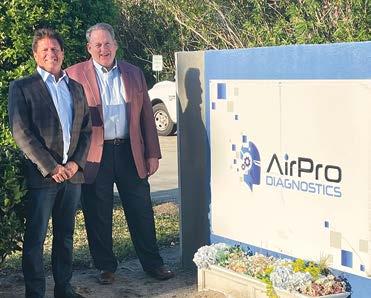
It comes down to two simple words: “brand specialists.” AirPro employs dealer-trained brand specialists, then trains them on collision dynamics and has them focus specifically on the vehicle brands they specialize in.
Margol is no stranger to solving these complex problems; his credits include being awarded the first patent in 2010 for inventing asTech.
Q: Why are shops struggling with these systems?
LM: We believe it is an unreasonable expectation that shops can safely service these complex networks and safety systems unique to each brand. A scan tool is only as good as the technician using it. Unless shops have the volume and financing to hire specialists to cover 45 brands, the safe solution is having AirPro lend its brand specialists to your shop on-demand.
We have a 97.7% success rate in all services requested. We take pride in staying with the shop and getting the car completed safely. This saves on untold cycle time and higher sublet expense.
Q: How complex are these systems?
LM: Right now, the industry as a whole can’t bridge this huge gap created by rapidly advancing technology, especially with so many of these very sophisticated systems and not enough knowledgeable skilled technicians to know how to perform diagnostics and the calibrations. There are so many nuances in these various different model vehicles, even by brand, that it really needs the attention of technicians who are doing this on a daily basis.
Q: When did you start AirPro Diagnostics?
LM: I started AirPro Diagnostics back in April 2016 and launched a totally different tool approach. The AirPro tool utilizes OEM-licensed software and multi-brand diagnostic applications resident and directly connected to the vehicle. In other words, the software and hardware are all connected at the vehicle, which is very different than the other remote providers.
They use the streaming method, which I invented, but it wasn’t designed for doing these types of sophisticated calibrations and other services back and forth across the internet.
Q: How do shops know AirPro techs are up on the newest technology?
LM: Most of our brand specialists come out of dealerships and have been trained on how to diagnose crash events. This is much different than simply pulling codes. And because AirPro brand specialists are diagnosing and calibrating mostly late model collision-damaged vehicles every day, we believe they possess greater skills than someone doing warranty work or servicing fuel injection systems. They do multiple calibrations every day to where it becomes second nature.
We take 40,000 calls every month and from all of the requests we get, we have been successful in servicing 97.7% of them across all manufacturers. We also have a 10-minute response pledge, and we guard that very closely because we know when the shops need service, they need it right away. We did almost half a million services last year and our on-tool response time was one minute and 32 seconds on average.
LM: We have had hundreds of shops tell us they purchased all the equipment and they don’t have the expertise on a given brand so they engage us. As mentioned earlier we can equip, train and assist shops to cost-effectively perform ADAS calibrations. It doesn’t make sense for shops to have tools and software for makes they don’t repair. We custom-tailor equipment solutions based on the shop’s historical workload.
Q: Do you document every service as well, for purposes of accountability and transparency?
MQ: Yes, we record each and every screen session during the service, whether it’s a scan, diagnostics or calibrations. We store all this in the cloud, if anyone ever questions what was performed, what version of the OE software was used, it’s available to our shops.
Q: Have you been able to trim cycle time for your customers?
MQ: Absolutely. If you’ve been following industry reports, national average cycle time has almost doubled to almost 20 days. There are certainly some supply chain issues, but the acceleration of technology and the limited skills of shop technicians is contributing to cycle in a significant way. We have techs with 25-30 years’ experience on one brand. These types of specialists are not growing on trees. Shops can go it alone or utilize our remote services. AirPro shops enjoy on average two days less cycle time when pre-/post-scanning every vehicle.
MQ:
I’ll reiterate, in case we do run into an anomaly with a particular vehicle, we can bring other technicians in to assist in and actually figure it out as a team, another reason for our high success
The question is, do you have the ability to serve 45 brands and 550 models, which we are able to do? And when technology advances---which it does every year---how do you get the training? And then what do you do if you have a guy who is highly skilled and he quits, goes on vacation or is out sick? What do you do? Your whole operation can grind to a halt.
“We take 40,000 calls every month and from all of the requests we get, we have been successful in servicing 97.7% of them across all manufacturers.”
LONNIE MARGOL FOUNDER AND CEO, AIRPRO DIAGNOSTICS

A Black former Tesla contract worker who refused a payout of $15 million last year in damages for severe racial harassment has been awarded $3.2 million by a federal jury in San Francisco.
Owen Diaz, who worked as a elevator operator at Tesla’s factory in Fremont, CA, sued the automaker in 2017 for violating a California law that prohibits employers from failing to address hostile work environments based on race or other protected traits. The first jury awarded Diaz $137 million in damages.
In June 2022, U.S. District Judge William Orrick agreed with the jury that Tesla was liable but significantly reduced the award to $15 million, giving Diaz two weeks to decide whether to accept the reduced award.
Diaz refused the deal and opted for a new trial on damages, seeking nearly $160 million. However, a federal jury in San Francisco on April 3 ordered Tesla to pay about $3.2 million to the
plaintiff—$175,000 in damages for emotional distress and $3 million in punitive damages designed to punish unlawful conduct and deter it in the future.
The former Tesla contract worker, who had been hired by a staffing agency, accused the EV maker of failing to act when he repeatedly complained to managers that employees at the Fremont factory frequently used racist slurs and drew swastikas, racist caricatures and racial epithets on walls and work areas.
Bernard Alexander, a lawyer for Diaz, argued his client’s “outlook on the world has been permanently changed” as a result of the harassment. “That is what happens when you take away a person’s safety,” he added.
During a testimony in late March, Diaz tearfully recounted various
Alex Spiro, said Diaz was a confrontational worker who exaggerated his claims of emotional distress. He added the plaintiff’s lawyers failed to demonstrate any serious, longlasting damage caused by Tesla. “They’re just throwing numbers up on the screen like this is some kind of game show,” Spiro said, according to Reuters.
Lawyers for Tesla said there were inconsistencies in Diaz’s testimony and repeatedly raised the fact that he did not lodge written complaints to supervisors. However, the plaintiff testified that he verbally complained to managers numerous times and discussed his complaints with Tesla human resources officials.
Car-O-Liner is celebrating its 50th anniversary. A special commemorative logo will mark the milestone.
“Since 1973, Car-O-Liner has been known for excellence, innovation and passion, offering customers a full line of state-of-theart collision repair solutions,” said Tim Garner, market development manager for Car-O-Liner. “From alignment and measuring equipment to state-of-the-art ADAS calibration, Car-O-Liner continues to lead the industry as we enter our next 50 years. We thank employees past and present and our loyal customers for being part of Car-OLiner’s successful journey.”
Today, Car-O-Liner provides a complete line of collision repair solutions, including alignment and straightening systems, joining and heating equipment, measuring systems, workshop solutions and testing and calibration systems. In
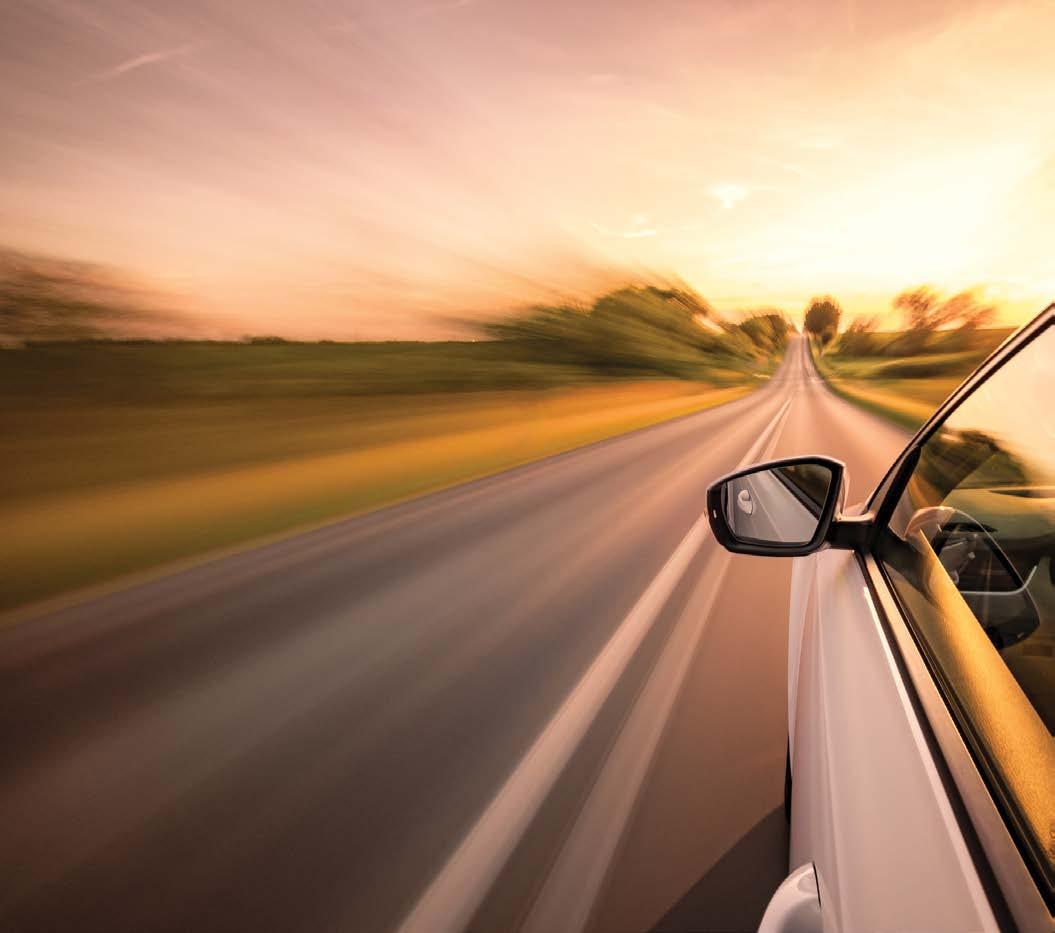
Significantly more shops now are using an invoicing system to bill for materials—at least some of the time—according to a “Who Pays for What” survey conducted earlier this year.
In 2021, a similar survey found about half of shops relied strictly on the multiplier method (a flat dollar amount per refinish hour) to bill for materials, while about 19% used a materials calculator or invoicing system. The percentage using the invoicing system exclusively remains essentially unchanged, but now more than 40% of shops say they use a mix of both methods. That’s up from about 32% in 2021, and means 3 in 5 shops are now using an invoicing system at least some of the time, 12 percentage points higher than eight years ago.
“I really think the large change we are seeing is due to the multiple increases in paint prices virtually all shops experienced since we last did this survey in January of 2022,” said Mike Anderson of Collision Advice, who conducts the quarterly “Who Pays” surveys in conjunction with CRASH Network. “More
Fix Auto USA announced the opening of Fix Auto Tujunga, located at 7001 Foothill Blvd., Tujunga CA 91042.


Kevin Tarverdyan, owner of Fix Auto Tujunga, joins the auto repair industry with nearly two decades of experience in the insurance industry. A close acquaintance in the auto
“I treat every car that comes through our door like my own car,” said Tarverdyan. “I take pride in being ‘too picky’ in order to ensure our team is fulfilling requests to the best of our ability. I do my part to keep the facility and its functions clean, organized and timely to deliver top-notch service to all.”
The new facility totals to 4,500 square feet and has a nimble team of four employees, with more looking to join. The facility is I-CAR Gold certified and will soon receive an I-CAR Platinum certification. Tarverdyan is proud to be a provider of exceptional service and expert repairs in a centrally located area.

A new poll revealed 31% of Americans still would not consider electric vehicles when purchasing their next car, while just over one-third would consider it.
The U.S. is currently in a serious EV push, as President Joe Biden wants 50% of all new vehicles sold in 2030 to be either batteryelectric or plug-in hybrid cars.
56% of respondents were not willing to pay more than $49,999 for an EV, a price point that’s already been met by some popular electric cars, such as the base Tesla Model 3, which starts at $42,990.
repair industry recommended Tarverdyan explore the collision repair side of the business. Tarverdyan quickly found his background in the insurance space coupled with his passion for the auto industry made for a natural connection in his new venture as an owner of a premier collision repair business.
“A determined and driven individual like Kevin Tarverdyan is the perfect match to continue growing our Fix Auto USA family,” said Damien Reyna, COO, U.S. collision, Driven Brands. “I look forward to seeing Kevin and his team flourish in this new facility and the continued operational growth of Fix Auto Tujunga.”
Source: Fix Auto USA


A recent seven-day poll from Reuters/Ipsos, which concluded March 20, revealed 34% of respondents were open to the idea of purchasing an electric car, while 31% responded they were not considering it. The survey also indicated Democrats were more inclined towards EVs, with 50% considering the idea. This number was only 26% among Republicans and 27% among independents.
The poll further revealed
Around 35% of the poll’s respondents also wanted an EV with 500 miles or more per charge, a metric only met currently by the Lucid Air. However, 37% of the poll’s respondents said they wanted a minimum range of 300 miles per charge, which has been achieved by several EVs on the road today, such as the Tesla Model Y and the Ford Mustang Mach-E, as well as premium EVs from younger companies like Rivian and Lucid.
The Reuters/Ipsos poll was conducted online. It involved 4,410 participants across the U.S., and its credibility interval is approximately 2 to 3 percentage points in either direction.

The California Energy Commission (CEC) is in the process of creating new regulations to require all tire retailers—including auto body shops—to post signs and provide disclosures to consumers purchasing replacement tires. The California Autobody Association (CAA) is concerned and is requesting the CEC provide an exemption for auto body and collision shops beginning April 1, 2025.
Should these regulations include body shops? In the past, collision
The auto body repair business is not in the primary business of selling tires to the general public but will locate a replacement tire to match the damaged tire as part of the collision repair. Consumers do not go to auto body shops to buy a new set of replacement tires. Consumers go to auto body repair facilities because of a vehicle accident and wish to have collision damage repaired. The auto body dealer is not a “tire dealer” or “tire retailer” as contemplated by these regulations. It would be unreasonable to expect an auto body repair shop to meet the proposed regulation requirements.
meet certain, dimension, point type and height requirements.”
Displaying pricing information for each replacement tire is unworkable for dealers. Some retail tire dealers have hundreds of tires in stock and prices change regularly due to economic factors. The tire dealer would literally need a sign for each tire, meaning hundreds of individual signs, and every time prices change, they would have to replace each sign. This is not practical.
Auto repair dealers such as auto body shops do not have tires in stock. They either order from a distributor or sublet the tire repairs. Having signs with pricing when they don’t even know the price until they purchase from a third party is unfair and unreasonable.
more paperwork for shops with these regulations too. Stated in the regulations, upon request of a customer, a tire dealer shall provide the customer with a Tire Energy Efficiency Disclosure for any replacement tire that the tire retailer offers for sale. The Tire Energy Efficiency Disclosure shall display the tire brand name, rolling resistance star rating, treadwear and traction rating, the peak traction rating, the operating cost and QR code to the Energy Commission’s Tire Replacement Program.
repair has gotten lumped in with other auto repair business categories. Is this the case with these new tire regulations?

Autobody News sat down with Jack Molodanof, CAA lobbyist, who shared the organization’s concerns about this proposed regulation and how it can affect body shops if passed as written.
Q:What are these regulations and why is the CAA concerned about how it will impact body shops?
A:These regulations are intended to implement a replacement tire program and tire star rating system to increase energy efficiency of replacement tires in California. The regulations are based on legislation that passed 20 years ago, AB 844. Overall, the CAA is supportive of efforts making tires more energy efficient for consumers. Unfortunately, the regulations are drafted so broadly that they capture and include auto body repair shops in the definition of tire dealers.
Auto body and collision repair facilities are auto repair dealers who perform repairs or reconstruction of automobile or truck bodies, structures or frames. While performing such collision repairs, it may be necessary replace a damaged wheel and tire.
The California Air Resources Board took such types of low volume businesses in consideration when they developed the “check and inflate” tire regulations and provided exemptions for certain businesses. As an alternative to an exemption, CAA has recommended the definition of tire dealer and retailer be revised to include only those that are primarily in the business of selling tires which would exempt the occasion tire replacement situations.
Q:If these regulations pass, will it create more work for body shops?
A:The language in the regulation requiring pricing information on signage for each replacement tire is vague, ambiguous and unworkable for auto repair shops. The regulations state “that each physical retail location must prominently display a tire replacement sign displaying the price of any replacement tire and also include California Tire Efficiency Rating and potential to reduce fuel consumption, the potential driver cost savings and general environmental benefits. The sign must display the web address and provide a QR code linking to the Energy Commission’s Replacement Tire Efficiency Program search page. The signs must also
The sign posting language requirements is restrictive, burdensome and may not accomplish the proposed regulation goals. The Bureau of Automotive Repair (BAR), which regulates all auto repair shops, including tire dealers, currently has its own sign requirements. The BAR requirements provide the shop flexibility to ensure signage is placed in a location where it is clearly visible to the general public, and these regulations should provide the same flexibility.
Q:Will these signs even be effective to educate consumers on tire efficiency? A: There are so many signs that are already required to be posted by dealers, such as BAR signs, Prop 65 signs, smog check signs, brake station signs, storage signs, battery fee signs, video recording signs, ADA signs, etc., and permit postings such as business licenses, fire permits, air quality management permits and the list goes on.
There is a proliferation of signs currently required to be posted by dealers and the question becomes: how effective would another sign be in a shop? Is this really the most effective way to educate consumers about tire efficiency? CAA is also concerned that the specific sign placement requirements may end up being an opportunity for predatory attorneys to file frivolous lawsuits against small businesses because the sign wasn’t in the proper location. Q: Are there any other concerns about the regulation? A: Independent verification of disclosure: There will be
The regulations are unclear whether the auto repair shop must independently verify these disclosures to make sure it’s accurate. Will the shop be able to rely on the tire manufacturer disclosures and simply pass information along to consumer without liability? It would be impractical to have a shop independently verify tire energy disclosure information for every tire it sells. Who is ultimately responsible for this information?
Existing inventory of tires: Do tire dealers have to stop selling noncompliant efficiency rated tires on Jan. 1, 2025? How do tire dealers handle exiting tire inventory that is noncompliant after the deadline to comply? Will tires manufactured before the deadline be exempt?
Identifying and confirming compliant tires: How do tire dealers easily ascertain and verify that the tires are California compliant? Will tire manufacturers be required to mark tires as California compliant? If so, with what type of markings? If not, how will the tire dealer ascertain and verify compliance?
Documentation: What documentation and records will be necessary for the tire dealer to show that they are in compliance?
Enforcement: Will the CEC be enforcing this new law or other agencies such as the BAR enforce?
Economic impacts and cost to small businesses: Has the CEC conducted any research or gathered any information as to the economic impacts and costs to small business ARDs, if these regulations were implemented?
“It would be unreasonable to expect an auto body repair shop to meet the proposed regulation requirements.”
JACK MOLODANOF CAA LOBBYIST

























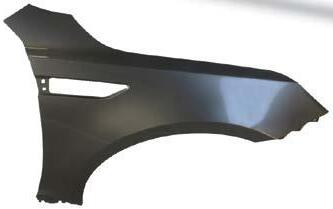








When the engines revved at Las Vegas Motor Speedway in early March, there were four new drivers in the field— four deserving Las Vegas families, including one military member.

They were presented with vehicles to provide them independence and the ability to work and take care of their families, thanks to the National Auto Body Council (NABC) Recycled Rides® program along with car donor GEICO and collision repair partner Caliber Collision, whose technicians donated their time and skills to refurbish the vehicles, along with support from Speedway Children’s Charities–Las Vegas Chapter.
The NABC Recycled Rides event, the first ever at a NASCAR race, was held during the NASCAR race weekend at Las Vegas Motor Speedway. Speedway Children’s Charities–Las Vegas Chapter selected the recipients through their charity partners, including Children’s Foundation of Las Vegas, Valley View Community Cares, Ronald McDonald House Charities and the YMCA of Southern Nevada.
The four Toyota vehicles were donated by GEICO, which has contributed more than 700 vehicles to the program. Caliber Collision handled the repairs at its Caliber Collision Meridien, ID, Caliber Collision Millcreek, UT, Caliber Collision El Paso West, TX, and Caliber Collision El Paso Zaragoza, TX, locations. Caliber has refurbished more than 500 cars through NABC Recycled Rides.
“It was incredible to work with our partners GEICO and Caliber to present four Las Vegas families with the gift of reliable transportation in front of thousands of NASCAR fans,” said Scott Sampley, chairman of the NABC Board of Directors. “Thank you to our host the Las Vegas Motor Speedway and our charity partner Speedway Children’s Charities–Las Vegas Chapter for making this possible. So many of our NABC members also support NASCAR, and this presentation was a powerful way to harness our collective involvement to change and save lives. We hope to continue to recognize deserving local community members at NASCAR events this season and unite our members in giving back to those in need.”
The recipients on March 4 were recognized on the Las Motor Speedway Fan Zone stage, where their vehicles were unveiled before a crowd of race fans. They included:


Lynette Brandon, who was nominated by YMCA of Southern Nevada, is a single mother of three chldren, one of whom has special
needs. She lost her vehicle in an accident several years ago, and lost her job in 2020. She now walks or takes the bus with her children to get them to school, appointments and activities. Lynette has secured a job and has goals of being a manager, and the support she receives from the YMCA of Southern Nevada for two of her children’s education and social needs makes it possible for her to work.
people when they need us most,” said Frank Pickering, vice president of operations, physical damage, GEICO. “We are honored and grateful for the opportunity to work with these great partners. We wish these recipients and their families many miles of enjoyment on the safe road ahead.”
On March 5, just before the green flag waved in the Pennzoil 400 NASCAR Cup Series race, NABC, GEICO and Caliber presented two vehicles on the pre-race stage right in front of the grandstands as race fans cheered for the recipients. They included:
She received a 2017 Toyota RAV4, and the gift of reliable transportation will allow her the time and independence to care for her family, and eliminate the daily fear she has walking home from the bus stop after work.
Pablo Sandoval, nominated by Ronald McDonald House Charities of Greater Las Vegas, along with his wife, Alejandra, and 6-year-old, Joshua, have endured an incredible four months of triumph, tragedy and hope. Pablo, Alejandra, who was pregnant with twins, and Joshua left their home country of Colombia when it became unsafe. They came to the U.S. with plans to settle in Florida with family, but Alejandra went into premature labor during a transfer in Las Vegas. Their twins were born at 22 weeks, and the Ronald McDonald House Charities stepped in to help care for the family during the twins’ hospitalization. Sadly, one of the twins passed, but the family is looking ahead and building their life in Las Vegas.
Pablo has gotten a job, enrolled his son in school, gotten his driver’s license and is working on his family’s official paperwork. Through this, they have been dependent on public transportation and the RMHC family shuttle. With the gift of a 2019 Toyota Camry, Pablo can now care for his family, more easily visit his hospitalized son, Jacobo, and embark on a fresh start and hope for the future with Las Vegas as their home.
“This was a special weekend for GEICO as we were able to continue our donation of vehicles to NABC Recycled Rides. Efforts like these demonstrate GEICO’s commitment to our communities and helping
Emilio Swann, who was nominated by the Children’s Foundation of Las Vegas, is an active-duty Marine who is training to join the Military Police K-9 unit. He just graduated from boot camp as second in his platoon in December 2022. He grew up in foster care, and lived in 20 different homes before he was 18 years old. He struggled with little help, worked very hard for everything and never lost his motivation to turn his life around. Today, he struggles with transportation to the base and daily activities. The gift of a 2015 Toyota Camry helps him continue his journey to success.
Ellen Mills, nominated by Valley

View Community Cares, has been part of Valley View Community Cares for more than 20 years. She started as a participant in the program, and later became a mentor providing relentless volunteer hours to children in the same community. Today, she is married with a son, and she and her husband have faced tremendous challenges. They lost their home and car in September 2022, and Ellen has faced serious health issues since then. They have been struggling to return to work, get stable housing and regain their health, all without a vehicle. The gift of a 2016 Toyota Prius helps them regain hope and continue to care for their family.
“This is truly an amazing gift and an incredible day,” said Mills, who was on stage for the NASCAR presentation. “My family and I are so appreciative. This will really help us get to work, go to medical appointments and take of everyone. Thank you to everyone involved.”
“As one of the nation’s largest automotive services provider, Caliber has built our business and culture around our purpose of Restoring the Rhythm of Your Life®. We are especially proud of our Caliber teammates, their commitment and
Lemonade, a digital insurance company powered by AI, on March 29 announced the launch of Lemonade Car in Oregon, marking the fifth state where the full suite of Lemonade insurance products are available.
As a state known for its environment-friendly ways and low-mileage drivers, Lemonade Car will be a welcome option for those in Oregon looking for car insurance that aligns with their values—and their wallet.
Lemonade Car offers drivers the ability to only pay for the miles they drive on top of a low monthly base price, perfect for those opting for their bike commute or working from home throughout the week. With the Lemonade app, this gives drivers a new option for car insurance with built-in safety features, including free crash detection and emergency services, and access to its quick, efficient claims process.
Additionally, Lemonade Car gives back to the planet by funding reforestation efforts throughout Oregon’s Santiam State Forest, known for its Douglas Fir and
Western Red Cedars, to help clean up the carbon emissions of its drivers.
With Lemonade, drivers across Oregon can access its top-rated insurance, including:
Determining their price with their mileage each month: Policies will be priced based on the driver’s mileage. With a low monthly base rate plus a few cents per mile, drivers will only pay for the miles they actually drive —perfect for low mileage drivers.
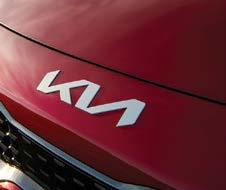


Benefits for environmentconscious drivers: Lemonade Car offers ideal coverage for low mileage drivers and funds reforestation to help clean up after customers’ carbon emissions, over time.
Fast claims and emergency services when needed: Lemonade Car features a first-of-its-kind claims process that allows customers to file claims in minutes, as well as the ability to customize coverages, add a new car, and more through the Lemonade app. When needed, drivers can also access tow services, emergency EV battery recharge, and the option to track
repairs, body shop work and more.
Insurance backed by data: With billions of miles of data under the hood, Lemonade Car has the expertise to provide low rates and handle claims quickly and efficiently.
Discounts for bundling: New and existing customers in Oregon can receive discounts when bundling with other Lemonade products— renters, homeowners, pet and life— to save up to hundreds of dollars a year.
Lemonade created a guide for drivers to help navigate the nuances of car insurance in the state of Oregon. Whether it’s a breakdown of what’s required or extra coverage that might be good to have, drivers can find it all in Lemonade’s Oregon car insurance guide.
Source: Lemonade
FREE 4x Monthly E-Newsletter.
www.autobodynews.com
CARSTAR has been ranked again among the fastest growing franchises in Entrepreneur magazine’s 2023 Fastest Growing Franchises List, coming in at 124th.
The 2023 ranking highlights the companies that saw the greatest franchise unit growth in the U.S. and Canada from July 2021 to July 2022.
The Fastest-Growing Franchises ranking is based on information submitted to Entrepreneur for its annual Franchise 500® and is part of the brand’s continuing effort to best understand and evaluate the ever-changing franchise marketplace. The ranking appears in the March/April 2023 issue of Entrepreneur. Recognized by entrepreneurs and franchisors as a top competitive tool of measurement, the Franchise 500 places CARSTAR 193rd on the list and first among collision repair companies.
Source: CARSTAR

Frank Terlep kicked off his first Collision Industry Conference as chairman this year by sharing what he sees as the “Top 10 influences” most likely “to affect our industry.” They include continued employee shortages, parts challenges and economic uncertainties. Consolidation also won’t slow down any time soon, he said.

“I predict you’re going to see a couple of the ‘mid-market’ consolidators come together,” Terlep said at the meeting held in Palm Springs, CA.
He said independent collision repairers will “continue to become part of something bigger,” whether that’s a franchise, network or 20 Group, or growing from one store to two or more.


designed for ADAS calibrations and services.”
In terms of parts-related challenges, Terlep said, “I think it’s going to get a little easier, but I don’t think it’s going to go away. I think we’re still going to have parts challenges through 2023.”
He said he sees OEM certifications becoming increasingly important this year.
Tools, and a variety of hand tools, including screwdriver and socket sets, vise grips, combination wrench set and a 24-inch pry bar, donated by Toby Chess. Other individuals contributing were Jordan Hendler, Barry Dorn, Jeff Hendler and Dale Matsumoto
“The major consolidators will continue to move more toward a greenfield model than a brownfield model,” he said. And the “ton” of continued consolidation among newcar dealers “is also going to drive bigger, larger dealer-based collision repair groups.”
Terlep called ADAS calibration work “the biggest business opportunity this industry has seen in the last 20 years,” but said it’s also “the biggest opportunity to fail.”
“Because ADAS and calibrations affect steering, braking, acceleration. We can’t bury our heads in the sand and not do this work right,” Terlep said. “It’s critical, and it’s the biggest opportunity in years.”
Terlep predicts more and more smaller multi-shop operators will open up their own ADAS and calibration centers.
“You’re also going to continue to see the big consolidators buy local and regional ADAS and calibration companies,” he said. “You’re going to see, in my opinion, a couple regional or national players get into the business of ADAS calibrations. And you’re going to see some new software in the market specifically
“Whether we like it or not, I think we’re going to hear more parts restrictions occurring by manufacturers,” he said. “And I also think from an OEM certification perspective, the OEM networks are going to want more data about what’s going on with cars. They want to know if the cars are being repaired correctly.”
Terlep said he foresees vehicle build data having increased importance for repairs and claims. “Because build data is such a critical piece to understand what’s on the vehicle, I think you’ll see a lot more of that being integrated in the thirdparty applications,” he said.
Lastly, watch for new ways to validate proper restoration of vehicles’ safety systems, “because if you’re doing ADAS repairs or calibrations, you must document this stuff as if you’re going to court tomorrow.”
Terlep’s presentation slides are available on the CIC website at ciclink. com/meeting-presentations/
Also during CIC in Palm Springs, three auto body and paint students from the Career Technical Education Center (CTEC) in Salem, OR, received tool boxes and tools courtesy of the March Taylor Memorial Fund.
Daniel Mendoza, Eddie Ceja and Jullian Moran each received Dewalt 20-volt drills donated by Kent Automotive, plastic dent repair kits donated by DentFix Equipment, Keco Tabs donated by that company, a 6-inch DA sander donated by Astro
Oregon shop owner Ron Reichen, who participates on the CTEC industry advisory board even though his shops are more than 40 miles away from the school, paid for airline tickets for the three students and their instructor, Alex Crays, to attend the CIC meeting for a presentation of the donations. The March Taylor Memorial Fund was established to benefit collision repair technicians. March Taylor was a shop owner in Hawaii who lived and worked in the trade; his life embodied the work done on the collision facility floor. The fund in his memory was established after his death in 2007.
companies are moving away from drug policies they previously had, sometimes citing widespread use of marijuana as making it too difficult to maintain the workforce they need. But King said that may or may not be true for shops, and urged them to discuss with their legal counsel the level of risk they are willing to accept.
“You’ve had me come here for 23 years to give you ways to protect your shops, whether you’re a single shop or a multi-shop owner, whatever you are,” he said. “You have, for the most part, your own personal interests, your retirement, tied up in your company. A different set of rules may apply to you. I can’t give you a blanket policy anymore. But there are things we can do to protect you…[but they will be] specific to you.”
FRANKEmployment law attorney Cory King, who has regularly offered presentations for employers at CIC, said changes in the legalization of marijuana in many states makes it prudent for shops to review their company’s drug policy and employment screening practices. A blanket policy valid in all jurisdictions is no longer possible, he said at the most recent CIC.
“I still want you to be prepared to drug test in a way your state will allow to happen. I still want you to do pre-employment screening, but we’re going to have to look at your state and your jurisdiction to make sure you’re doing it in a legal manner,” King said.
He acknowledged some large
During another CIC panel discussion, Marty Ellingsworth of J.D. Power’s property and casualty insurance intelligence group said one auto insurance company’s experience with digital interaction with its customers could be of interest to the industry. While vehicle telematics will eventually help change first notice of loss and other aspects of the claims process for drivers of vehicles equipped with such technology, Ellingsworth said, that doesn’t mean other drivers don’t also want a shift to more digital interaction.
“There’s one [insurance] company in particular that serves a nonstandard insurance population and [insures] many older cars, [yet] was a top performer in digital improvement,” Ellingsworth said. “I called them to ask what they did. They said: ‘When we clear our voicemail at night, we text people the answer.’ So analog in, digital out, with a text. The people were so much happier just getting an update digitally, and having another channel to communicate. It’s a blinding flash of the obvious, but it’s a nontraditional way to innovate.”
“Because ADAS and calibrations affect steering, braking, acceleration. We can’t bury our heads in the sand and not do this work right.”
TERLEP CIC CHAIRMAN
Sponsored
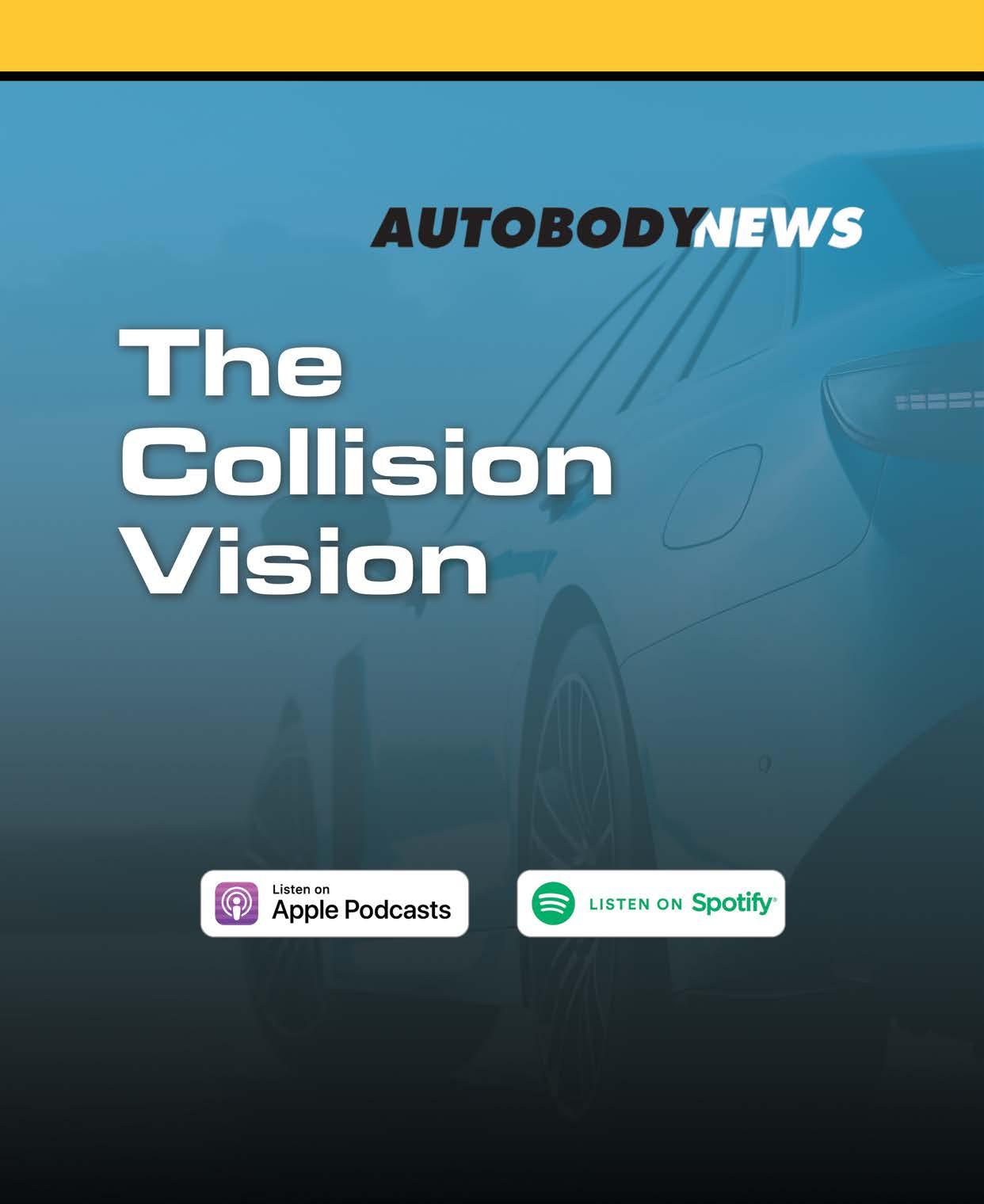
Mike Anderson
David Leuhr
Brandon Eckonrode
Ryan Evans
Rivian
& many more

Please contact these dealers for your Honda or Acura Genuine parts needs.
Barber Honda Bakersfield
661-396-4235
Dept Hours: M-F 8-5:30 bestchoice@barberhonda com
Capitol Honda San Jose
408-445-4412
Dept Hours: Mon-Sat 7:30-6; Sun 8-5 sbettencourt@penskeautomotive com
Concord Honda Concord
925-825-8016
Dept Hours: M-F 8-6 kevin valenzuela@concordhonda com
Galpin Honda Mission Hills
800-GO GALPIN
818-778-2005
Dept Hours: M-F 7:30-6; Sat 8-2 mteeman@galpin com
Honda of El Cajon
El Cajon
619-440-5851
Dept Hours: M-F 7-6; Sat 7-5 parts@hondaofelcajon com
Honda of Hollywood Hollywood
800-371-3719
323-466-3205
Dept Hours: M-F 8-6 parts@hondaofhollywood com
ACURA
CALIFORNIA
Acura of Concord Concord
925-680-4233
Dept Hours: Mon-Sat 7-6 keith�whisten@cacargroup�com
Acura of Fremont Fremont
888-435-0504
510-431-2560
Dept Hours: M-F 8-6; Sat 8-5 mike ohare@acuraoffremont com
Acura of Pleasanton Pleasanton
888-985-6342
925-251-7126
Dept Hours: M-F 7:30-6; Sat 8-6 mitch cash@hendrickauto com
Honda of Pasadena Pasadena
800-433-0676
626-683-5880
Dept Hours: M-F 8-6; Sat 8-4
Honda of the Desert Cathedral City
760-770-0828
Dept Hours: M-F 7-6; Sat 7-5 mpartridge@honda111 com
Keyes Honda Van Nuys
818-756-6549
Dept Hours: M-F 8-6; Sat 8-5 malvarez@keyeshonda com
Larry Hopkins Honda
Sunnyvale
408-720-0221
408-736-2608
Dept� Hours: M-Sat 8-5 parts1@hopkinsdirect com
Metro Honda Montclair
800-446-5697
909-625-8960
Dept Hours: M-F 7:30-5:30; Sat 7:30-4 wholesaleparts@metrohonda�com
Ocean Honda Santa Cruz
831-464-1800
Dept Hours: M-F 7-6; Sat 8-4:30 mickw@oceanhondasantacruz�com
Pacific Honda San Diego
858-565-9402 jgardiner@pacifichonda com
AutoNation Acura
Torrance
310-784-8664
310-539-3636
Dept Hours: M-F 7-7; Sat 8-5 alvaradow1@autonation com
Bakersfield Acura
Bakersfield
661-381-2600
Dept Hours: M-F 7:30-5:30 bakersfieldacuraservice@yahoo com
Marin Acura
Corte Madera
800-77-Acura
415-927-5350
Dept Hours: M-F 8-5:30; Sat 8-4 parts@marinacura com
San Francisco Honda
San Francisco
415-913-5125
Dept Hours: M-F 8-5 partsws@sfhonda com
Scott Robinson Honda Torrance
310-371-8320
Dept Hours: M-F 7-6:30; Sat 7-5 mluna@scottrobinson com
Selma Honda Selma
800-717-3562
559-891-5111
Dept Hours: M-F 7-6; Sat 7:30-4:30 hondapartsmgr@selmaautomall com
Larry H. Miller Honda
Boise
888-941-2218
208-947-6060
Dept Hours: M-F 7-6; Sat 8-5
Hinshaw’s Honda
Auburn
253-288-1069
Dept Hours: M-F 7-6; Sat 7:30-4:30 rickb@hinshaws com
McCurley Integrity Honda
Richland
800-456-6257
509-547-7924
Dept Hours: M-F 8-5:30; Sat 8-4 hondaparts@mccurley net
South Tacoma Honda
Tacoma
888-497-2410
253-474-7541
Dept Hours: M-F 7:30-6; Sat 8-5 bgregory@southtacomahonda com
Metro Acura Montclair
800-446-5697
909-625-8960
Dept Hours: M-F 7:30-5:30 wholesaleparts@metrohonda com
Acura of Honolulu Honolulu
866-931-9086
808-942-4557
Dept Hours: M-F 8-5; Sat 8-4
Johara@lithia com
Tokuda@lithia com
RayleenGarcia@lithia�com
Hinshaw’s Acura Fife
253-926-3331
Dept Hours: M-F 7-6; Sat 8-5 johnny@hinshaws�com
The automotive industry’s most important and prestigious awards ceremony, the World Car of the Year Awards Powered by Brembo, was held at the New York International Auto Show.
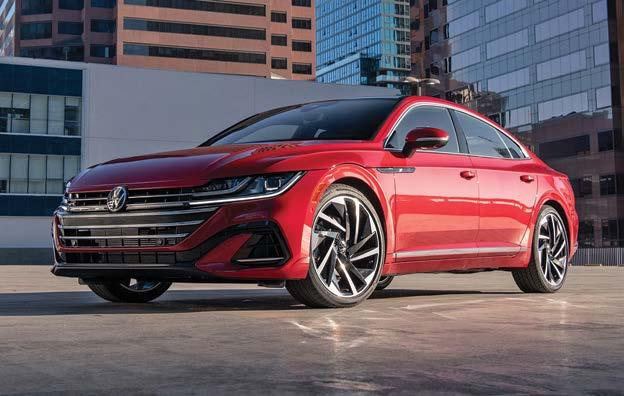
Hyundai’s Ioniq 6 electric sedan was the show’s star, taking home three of the six categories, including the World Electric Vehicle of the Year and the overall Car of the Year.
Hyundai’s sister company, Kia, also won the World Performance Car of the Year award with the EV6 GT. The Lucid Air won the World Luxury Car, and the Citroën C3 was named the World Urban Car.

Hyundai’s Ioniq 6 has certainly caught the automotive world’s attention with its impressive range, power and design. The electric sedan’s accolades at the World Car of the Year Awards add to its impressive resume.
Kia’s EV6 GT was also a

formidable competitor, earning the World Performance Car of the Year award. With these two models leading the way, it’s clear the future of the automotive industry is electric, and Hyundai Motor Corporation is leading the charge.
CAWA has joined other association leaders to support the critical global Right to Repair movement by signing a new position statement.
The statement enumerates the core beliefs of the movement and the objectives and intended outcomes of Right to Repair legislation. Importantly, the document sets forth 10 best practice principles to developing a framework for Right to Repair legislation any supporting country can use and adapt to its needs.
Without the convenience and choice of independent parts and repair, especially in suburban and rural communities, consumers will have limited access to affordable vehicle service and repair. These restrictions can have catastrophic effects on local economies and the well-being and safety of millions who rely on vehicle transportation daily.

The Ioniq 6 is the second vehicle from the Hyundai Motor Corporation to win three categories at the World Car of the Year awards. The electric sedan costs $41,600 in the U.S. and comes standard with an impressive technology suite, including twin 12.3-inch screens. Its longest-range trim can travel up to 361 miles per charge, while the highest-power, twin-motor specification delivers up to 320 hp.
Globally, the automotive aftermarket keeps 1.5 billion vehicles on the road while contributing $1.8 trillion to the global economy. After vehicles exit their warranty period, independent repair shops perform 70% of repairs. This vibrant industry and the consumer choice it creates is being threatened by automotive manufacturers that block access to wirelessly transmitted vehicle repair and maintenance data.

“We are pleased to be a part of this global Right to Repair movement and will do what we can to promote Right to Repair legislation which is so critical to the consumers’ right to choose where they get their vehicles repaired and where they purchase their parts,” said CAWA President and CEO Rodney Pierini.
Source: CAWA

 By Steven Loveday InsideEVs
By Steven Loveday InsideEVs
Electrify America opened its first fast charging station in Hawaii, which means the network is now present in 47 states plus the District of Columbia.

According to the company, its network is the largest open DC fast charging network in the U.S., and currently includes 800 stations and another 112 coming soon, with 4,379 individual chargers and 116 Level 2 AC charging points.
In the following year, Electrify America and Electrify Canada expect to expand the network significantly. By 2026, the number of stations in the U.S. and Canada should exceed 1,800, while the number of individual chargers should exceed 10,000.
The new charging station is in Pearl City on the island of Oahu and features four 150-kilowatt chargers. Because it is an island, there was no need to install the 350-kW chargers.
A map on Electrify America’s website indicates there are two more charging stations planned on Oahu, one in Kapolei and one in Honolulu. There is no info about the other islands.
It means the average number of DC fast charging stalls is expected to remain the same— around 5.5 stalls per station.
The other large DC fast charging networks in the U.S. are EVgo and ChargePoint. Electrify America will likely also have to compete soon with the Tesla Supercharging network, which will be opened to non-Tesla EVs and equipped with CCS1compatible plugs.
J.D. Power said March 29 it is collaborating with connected vehicle analytics and infrastructure company Motorq to provide insights to the auto industry based on connected vehicle data. And this partnership kicks off with used electric vehicles—specifically, data to measure EV battery health. The companies will use data from actual vehicles and work with OEMs to help EV owners and shoppers compare a used EV’s current battery health with its prior status when new. J.D. Power will provide a validation to vehicles meeting a pre-determined battery health score. “EV shoppers have concerns about range and battery longevity,” J.D. Power VP and Head of Connected Vehicles Dave Sargent said in a news release.
“For used EVs, the range can be affected by a number of factors including how the vehicle has been driven and charged, and the temperature where it is being operated,” Sargent said.
“By measuring the precise
state of health of an individual EV battery over time, J.D. Power and Motorq will provide transparency into an area where it is difficult for the consumer to make their own assessment. This information will give used EV shoppers greater confidence that they are buying a high-quality vehicle at a fair price,” Sargent said. To determine the performance of an EV’s battery, the two companies plan to consider “thousands of measurements” over a vehicle’s lifecycle. They also are in talks with OEMs and “other industry participants” to bring EV battery health data to the industry, J.D. Power said. “The most useful way of measuring the health of an EV battery is to see how it performs in the real world,” Motorq co-founder and CEO Arun Rajagopalan said in a news release. “We have developed a capability that leverages thousands of data points a day from each vehicle, takes account of different operating conditions and provides a normalized assessment of the true health of each individual vehicle’s battery.”

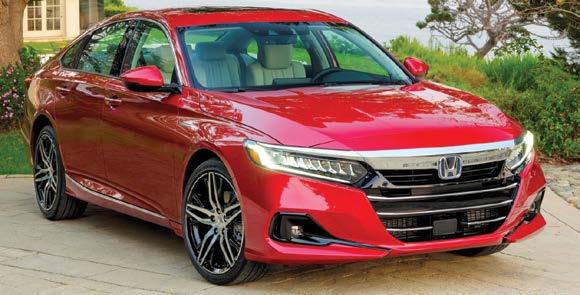
Mike Anderson of Collision Advice is well-known in the collision repair industry as a speaker and trainer, but for 25 years, he’s also led multiple groups of about of about 20 auto body shops, each from a different market—more than 400 businesses in all—who come together quarterly to compare financial and performance benchmarks, look for solutions for challenges facing their businesses or the industry, and help one another improve.
Starting last year, Anderson launched a new 20 Group, called the Spartans. Autobody News asked him about what spurred the change, and how a collision repair business can become—and benefit from—being a Spartan.
Q:What led to the formation of the Spartans?
A:I had the honor and privilege of doing 20 Groups for Axalta Coatings for over 25 years. When COVID hit and I wasn’t traveling 300 days a year for the first time, I had time to reflect on some things.
If you’ve ever watched that movie “Jerry Maguire,” Tom Cruise’s character has a sort of epiphany in the middle of the night, and he writes a letter about what he believes and what he’s going to do. I had my own type of Jerry Maguire moment during the early days of COVID.
As my business had changed, I’d been working with more automakers. I realized there were a lot of shops that were OEM-certified and really trying to do the right thing. But they likely at times felt like they were alone on an island. I know I felt that way a lot when I had my shops. So I wanted to focus on helping those OEM-certified shops, those trying to do the right thing, regardless of the paint line they use. We needed the groups to be paint-neutral.
Q:So OEM certifications are required to participate?
they have the intent to do the right thing, they have committed to that, and with that, my team and I can then coach them and help them improve.
I emailed some shops to tell them about my vision for the Spartans, and asked if they would be interested in attending a meeting to talk about it. We had 28 or 30 people at that first meeting.
Q: And it’s grown from there?
A: We are already up to four Spartan groups, with 77 members that combined have almost 160 locations. That’s after about six months since we launched. We’re very selective on who we take. You have to be nominated by a member or go through an approval process.
Each group is made up of shops that tend to specialize in a certain type of vehicle, such as one group that specializes mostly in high-end European vehicles. Not to say they
So we have a dashboard that we built with CCI. It pulls information about closed repair orders from each shop’s management system. It allows us to compare information on each shop, and can even segment it down by make and model of vehicle, by estimator, by what insurer was involved.
I can see, for example, that this shop repaired three BMW 328is, and this is all the data for those jobs: body labor hours, paint labor hours, mechanical, frame, CSI scores, cycle time, etc. I don’t know anyone in the industry who has built what we’ve built.
We also have reports so that as a coach, I can get on the phone with them and say, for example: “Your receivables are way out of whack. You need to get on that and collect your money.” Or I can tell this shop they are averaging—and I’m making these number up here—10 refinish labor hours per job, while that company’s two other shops are averaging 12, and the Spartan group as a whole is averaging 11. So we do a lot of data analysis, and we’re helping people to compare.
Q:How else do you see being a Spartan as helpful for a collision repair business?
A:The Spartans want to be a resource for one another. A Spartan in Florida couldn’t locate a part the shop needed locally; Frank Rinaudo, a Spartan in Louisiana, found the part there, and personally drove it six hours to the Florida shop, just to help them out.
We had another Spartan member who lost a painter and was really backed up. One of the other Spartans flew his painter there for a weekend to help the shop catch up.
Q:Is there anything else you would like to add? What if an OEMcertified collision repair shop wants to find out more about becoming a Spartan?
A:They can visit the Collision Advice website (collisionadvice. com) for more information and ways to contact us. I think it is important that people understand we are not a banner group or franchise model—I have a great working relationship with some of those—and we are also not anti-insurance. We are a coaching and training company that is collaborating with shops and all industry stakeholders to identify areas of opportunity or improvement or solutions for the industry.
don’t fix other vehicles, but it’s what they specialize in. Because we see performance benchmarks can vary based on what types of vehicles a shop frequently fixes. The goal is to help a Toyota-certified shop, for example, compare themselves against other Toyota-certified shops.
We have independent and dealership shops, some with a single location, others with as many as 12 or 16 locations.
Q: So what’s involved for a shop that’s a Spartan?
A:
Yes, you need to have at least one OEM certification, and be committed to safe and proper repairs. You have to agree that you will pre- and post-repair scan every vehicle with an OEM scan tool or an OEM-approved device, for example, and that you will set-up and perform destructive test welds on every vehicle requiring welding.
I feel I should say: I am not naïve enough to believe that everybody in my group is doing the exact right thing every single time. But at least

A: We meet in person once a quarter. Our goal is help drive positive conversations about solutions. We also do monthly webinars, featuring an automaker, an insurer or an industry vendor. We recently just mystery-called all our shops, for example, and recorded how they answered the phone. We played that for them, and then also helped them build scripts to improve that process.
We now have 13 team members who also do weekly coaching calls with each shop, where we go over data to help them with their business. I knew we would need some software to track data and performance.
“So I felt like we needed to focus on helping those OEMcertified shops, those who are trying to do the right thing, no matter what paint line they use.” MIKE ANDERSON COLLISION ADVICE

Tesla CEO Elon Musk has said the Cybertruck may start initial production this summer, so it is no surprise to see Tesla testing the Cybertruck with what appears to be wheel calibrating equipment.
This was hinted at in a recent sighting of the Tesla Cybertruck in Fremont, CA. Images showed the vehicle equipped with what appeared to be a series of sensors. Its wheels were also particularly eye-catching.
As noted by members of the Cybertruck Owners Forum, mounted on the steel wheels were what appear to be wheel force transducers, designed to aid in the evaluation and advancement of complete vehicle chassis and their components. They are used in a wide range of vehicles, from sedans, SUVs and commercial vehicles to race cars and industrial vehicles. When in use, wheel force transducers
typically take the place of a regular wheel, measuring the forces and moments that act upon the tire’s contact patch.
The Tesla Cybertruck has been described by executives as the company’s masterpiece for now. It is expected to adopt numerous features, including rear-wheel steering. Such features may require more calibrating work if they are to be used with systems such as Autopilot and FSD.
This may not be the first time a Cybertruck prototype with apparent wheel force transducers has been spotted in the wild. Last August, a battle-weary Cybertruck unit was photographed being offloaded from a transport truck. Similar to the Cybertruck in the recent sighting, the vehicle was outfitted with numerous sensors then. It was also equipped with wheels that looked very similar to those in the recent prototype.
Oregon’s electric vehicle incentive program—widely publicized for bringing the price of a Tesla Model 3 well below $30,000—is being suspended for a year starting in May, because it is running out of money.
According to a new report from Oregon Live, the Oregon Department of Environmental Quality’s Clean Vehicle Rebate Program has paid out more than $71 million to help buy or lease roughly 25,000 EVs in the past five years.
In February, it was reported the incentives had pushed Model 3 prices from nearly $44,000 to between $26,990 and $28,390, making the Tesla mass-market sedan extremely affordable, bringing it within the territory of the Toyota Corolla in terms of pricing.
The incentive program allowed all state residents to stack the

$7,500 federal tax credit with the state’s $2,500 Clean Vehicle Rebate; and low- and moderateincome residents could get an additional $5,000 rebate.
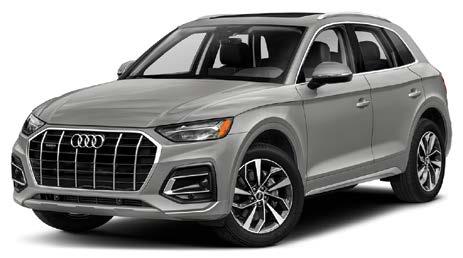

According to Fox Business, Oregon expects 1.5 million people to be driving EVs in the state by 2035. In December, state policymakers banned the sale of new gas-powered vehicles by 2035.
Incentives are a big part of the EV buying experience, as the price of the vehicle and where its materials are sourced can all contribute to whether or not it qualifies for incentives. In an attempt to get more EVs on the road, states have offered their own incentive programs, and they vary from location to location.
passion to donate their time and talent to restore vehicles for four deserving families,” said Todd Dillender, COO for Caliber. “We’re grateful for our continued partnership with GEICO and NABC Recycled Rides, gifting safe and reliable transportation across the communities we serve.”
NABC Recycled Rides is a unique program in which businesses representing all facets of the collision repair industry team up to repair and donate vehicles to individuals and families in need of reliable transportation. Since the inception of the NABC Recycled Rides program in 2007, members of the NABC have donated more than 3,000 vehicles valued at some $42 million.
Additional partners in the NABC Recycled Rides presentation include Enterprise, Co-Part, 1-800 Charity Cars, LKQ, AutoZone, Tire & Brakes Service, Protech, Big O Tire, Jiffy Lube, O’Reilly’s/First Call Auto Parts, Karl Malone Toyota, Krams Professional Detailing, Caliber Auto Glass, Alloy Wheel and AutoNation Toyota Tempe.


Sometimes the oldest and simplest solutions are the best. And sometimes they’re the only ones that work.
Which is why Hyundai Motor Co. is giving away 1980s-style steering wheel locks in a desperate attempt to tackle a car theft epidemic fueled by viral TikTok videos.
The TikTok videos showing how easy it is to steal many Hyundais and Kias because they aren’t fitted with electronic engine immobilizers have to led hundreds, if not thousands of people, including those with no previous history of car crime, to have a go themselves at boosting Korean cars, and the fallout is colossal.
Some insurance companies are refusing to cover certain Kia and Hyundai vehicles built before November 2021, when engine immobilizers became standard, and one police department claimed 80% of

the vehicles stolen in its district last year were either Kias or Hyundais, Bloomberg reported.

Hyundai Motor said it has already rolled out a theftprevention software upgrade to 1 million drivers and will extend the offer to another 3 million in

states have written to Kia and Hyundai accusing them of moving too slowly to remedy the situation, and both Seattle and St. Louis are suing the automakers for their role in the chaos.
There’s a perverse irony in a company that has been such a trailblazer for tech in relatively affordable cars, one that brought 400-volt charging and camera-based door mirrors to regular drivers, having to resort to such a basic, old-fashioned and very mechanical solution.

the coming weeks. But that’s still several weeks of worrying about whether your car is going to be there when you leave the house in the morning, so Hyundai is offering free steering locks and will reimburse anyone who has already purchased one.
The steering wheel locks aren’t infallible, one of the reasons we all stopped using them, along with them being a pain to fit, remove and store. The locks themselves might be tough, but the steering wheels aren’t. I knew a few car thieves back in the early 1990s when this kind of security system was normal and a quick snip through the steering wheel rim


When technician Justin Brockner isn’t fixing cars, he and his wife, Candice, run a 17-acre farm that has quickly become an attraction for people in Brook Park, MN, and the surrounding area. They call it Holistic Homestead and six years ago, this couple added farming to the growing list of amazing things they do—including parenting three boys with a girl on the way, homeschooling, physique competitions, Candice’s line of healthy products and Justin working at local body shops to pay the bills.
Justin’s career in collision repair goes back more than two decades.

“I have been working on cars pretty much my entire life,” Justin said. “My dad was a self-employed mechanic who did a lot of restorations and had his own car collections. I kind of grew up around cars and in the automotive repair industry.

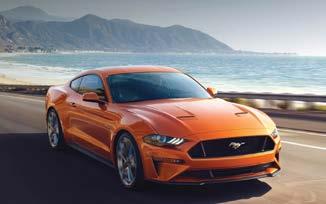

supplies, games and an entire room dedicated to children and babies.
The Brockners have always had big plans for their farm and boutique.
animals; we wanted to get into dairy goats. We wanted the land and we wanted to use the barn for animals, but we also had this house sitting there
Now the homestead holds events for the community during the year.
“We do a Summer Solstice Festival in June and then we did another festival in August, like an end of summer festival,” Candice said. “And then all through October, we are open every weekend. We created a lot of little activities for families and we invite people to hang out here, with picnic tables set up all over the property.”
The couple is into competitive-level fitness in addition to running their farm and boutique, Justin said.
“We entered physique competitions there for a little while, and we did other coaching,” he said. “I have a health and wellness coaching certificate; Candice is a certified holistic nutritionist and we try to motivate people to pursue their goals and dreams, and coaching them is a big part of it.”
“I worked in a service station in high school, doing oil changes and wheel alignments,” Justin continued. “I went to body school for a two-year degree and I have been working in collision repair since then. I did my first restoration when I was probably 12 or 13, and I took it to the state fair. It was a 1948 International pickup.”
The family’s farm began in 2017 with flowers, and now the family raises chickens, rabbits, goats and ducks, and grows a wide range of organic produce and bulk herbs.
“We would always just plant flowers to pollinate our gardens,” Candice said. “Then it turned into selling those flowers and into selling extra vegetables and eggs, as well as raising pastured poultry for our family and community.”
In October 2021, the couple opened the Holistic Homestead Farm Boutique, an “occasional boutique” open most weekends, offering a variety of unique items, including a line of handcrafted herbal remedies, kitchenware, pantry staples, home decor, many gift options, apparel, books, seeds, gardening
“The business has evolved naturally,” Candice said. “Everything we make and grow is first for our family and then the rest is for the community. At the beginning, we just wanted to have a space where people could gather and where we could share what we have here. Families love this place because it’s a beautiful spot and they can come here and unwind.”
The farm is in their DNA, Candice said.
“Well, I suppose it was kind of our way of living and being self-sufficient,” she said. “We’ve been gardening since our early 20s, canning food for our family. But it was about, I would say, six years ago when we launched the business initially with our herbal remedies. It all kind of just started as a way of life. You know, things that we use, and make ourselves and wanted to share them with other people. Over the years, that just evolved into wanting to have a space to offer to the community, for just a space for people to gather.”
When opportunity knocked to expand the farm, the Brockners answered the call, Justin said.
“The farm next to our homestead is about 710 acres and it went up for sale in the summer of 2021,” he said. “We were always talking to a neighbor about wanting to get some of that land from him. So, when it went up for sale, we thought this is our chance to expand. There’s a very nice barn on the property which would enable us to have more
and it just seemed like the perfect opportunity to offer our products to the community through this outlet.”
It all ties into what the Brockners are doing at Holistic Homestead—pursuing their passion and teaching people a new and healthier way of living along the way.

Visit their website at www. holistichomesteadmn.com.


“Everything we make or grow is first for our family and then the rest is for the community. At the beginning, we just wanted to have a space where people could gather and where we could share what we have here.”
CANDICE BROCKNER HOLISTIC HOMESTEAD







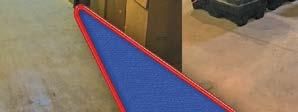

In late 2022, the Insurance Institute for Highway Safety (IIHS) did a simulation to assess whether its crash test equipment could handle a large and heavy EV. The equipment fared just fine, but the testing stirred up conversations about future safety concerns thanks to the EVs’ heavy battery packs.
The IIHS used an old gaspowered Ford F-150 pickup truck and loaded it up until it weighed a whopping 9,500 pounds. The heavy pickup was then put through the organization’s series of crash tests. While the tests were successful and the equipment unharmed, IIHS Vice President Raul Arbelaez was left wondering what strategies could be employed to increase safety with such heavy cars on the road.

Arbelaez is concerned about the weight of electric cars as compared to their non-electric counterparts. In a crash, two such vehicles’ weight disparity could be a serious issue. With more of these heavy EVs taking

to our roads, he’s also worried about pedestrians and cyclists.
According to Autoblog, the IIHS vice president wrote: “We don’t need to put the brakes on electrification— there are good reasons for it—and we’re not doomed to reverse all the safety gains of recent decades. But the development will require some new thinking about the kinds of vehicles we want on our roads.”
The IIHS VP said when millions of new EVs weigh much more than a Chevrolet Suburban and also have loads of power, they probably also need to have much more robust braking systems and crashavoidance technologies. He also pondered how “additional crash structures” could be manufactured into EVs to help protect lighter cars and people.
While many folks may agree with such suggestions from Arbelaez, he also wrote: “States and local governments should consider lowering speed limits, factoring in the increased danger from weight disparities, and backing them up with increased enforcement.”


The Northwest Auto Care Alliance (NWACA) is holding a Collision Training Expo on May 6 at Clover Park Technical School in Lakewood, WA.
This all-day training event for the collision repair industry is the first of its kind to be held in the Pacific Northwest, and will feature classes, demonstrations and exhibitors.
The expo will feature educators from CCC, 3M, LKQ/Elitek, Wesco, ATI and LDC teaching attendees how to use their equipment; classes on ADAS, collision management, modern vehicle adhesives and collision estimating; and hands-on training on welding and advanced metals, and blueprinting for estimating and repair.
The expo will be held 8:30 a.m. to 4:30 p.m. with a two-hour lunch break from 11:30 a.m. to 1:30 p.m., at which time attendees will
be able to visit an exhibitor area to talk to representatives of collisionrelated businesses.

Micah Strom, collison chair for the NWACA and a body shop owner, said the association has hosted a training expo for mechanical shops for 20 years and felt it was time to offer the same to its collision shop members.
“We started the CTE for our members and for the industry in general, to get some good training out there,” Strom said. “There’s not a lot [of collision training] here in the Northwest, and that’s why we put this together.”
The CTE will become a regular annual event, he added.
Registration is $175 for NWACA members and $250 for non-members.

For more information and to register, visit www. ctetrainingexpo.com.
For more information on NWACA, visit nwautocare.org.
www.autobodynews.com
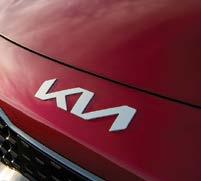
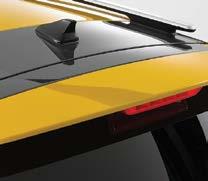
Financing a new vehicle purchase continues to grow increasingly out of reach for many consumers, according to the car shopping experts at Edmunds.
New data from Edmunds revealed:
The average annual percentage rate (APR) on new financed vehicles in Q1 2023 climbed to 7%, compared to 4.4% in Q1 2022, the highest level Edmunds has on record since Q1 2008. However, Edmunds analysts note March marked the first time after 14 consecutive months of increases that the average new-vehicle APR stayed flat (at 7%), which they attribute to a moderate increase in subsidized financing by automakers.


The average monthly payment for new vehicles hit a record high of $730 in Q1 2023, compared to $656 in Q1 2022.
16.8% of consumers who financed a new vehicle in Q1 2023 committed to a monthly payment of $1,000 or more—a new all-time high according to Edmunds—compared to 10.3% in
Q1 2022 and 6.2% in Q1 2021.
The average down payment for a new vehicle climbed to a record high of $6,956 in Q1 2023, compared to $6,083 in Q1 2022.
“Since inventory levels are improving, interest rates are now topping the list of the greatest obstacles that automakers will be facing in 2023 to move metal,” said Jessica Caldwell , Edmunds’ executive director of insights. “But with major challenges come great opportunities: Since interest rates are at the forefront of consumers’ minds, any automaker or dealer that can advertise incentives related specifically to interest rates will likely get more attention. This could be a powerful marketing tool that would enable sellers to tap into the significant pent-up demand that has been building over the past few years and convert that demand into actual sales.”
Edmunds analysts took a closer look at financed new vehicle purchases in Q1 2023 and calculated the average monthly payment, amount financed, APR, down payment and total interest
paid—in each case based on loan term lengths.
Edmunds experts note these figures highlight the stark contrast between the consumers who are able to take advantage of lower APR offers and those who
12.3% of consumers opted for 36- or 48-month loan terms in Q1, the highest Edmunds has on record since Q4 2009, while a majority of consumers are extending loan terms out as much as possible in order to increase affordability.
can’t. Although quarterly figures appear to reflect the average loan term has remained static at around 70 months, Edmunds analysts say term lengths don’t tell the full story—which is that more car shoppers are being pushed to the extreme ends of the finance terms spectrum.
Audi Burlingame Burlingame
888.737.5738
650.348.0883
650.348.0837 Fax
M-F 7:30am-4:30pm parts@rectormotors.com
Audi Rocklin Rocklin
866.948.0048
916.836.1286
916.836.1293 Fax
M-F 7:30am-6pm
Sat 8am-5pm parts@audirocklin.com
Audi Long Beach Long Beach
562.610.4170
562.343.5088 Fax
M-F 7:30am-5pm wholesale@audilb.com parts@audilb.com www.audilb.com
“It takes money to save money in today’s market. Although more automakers are offering to subsidize auto loans with lower interest rates, the catch is that most of these offers require that consumers agree to shorter 36- or 48-month loan terms— which might put people off at first glance,” said Ivan Drury, Edmunds’ director of insights. “If you’re a qualified buyer and have the means to put more money down, whether in cash or via your trade-in, know that you have a serious advantage— you’ll be committing to a much larger amount toward the down or monthly payment, but you will save up to tens of thousands of dollars over the course of your auto loan.”
S ource: Edmunds
Niello Audi Sacramento
916-480-2851
916.483.1963 Fax
M-S 8am-5pm audi.parts@niello.com www.audi.niello.com
Santa Monica Audi Santa Monica
310.481.8216
310.393.6982 Fax
M-F 7:30am-5pm
wholesale@santamonicaaudi.com www.santamonicaaudi.com
WASHINGTON
Audi Seattle Seattle
206.634.8200
206.547.1581 Fax
M-F 7am-6pm
parts@uvwaudi.com www.audiseattle.com
Regardless of the age of your customer’s Audi, Audi dealers have access to over 200,000 part numbers and are supported by a nationwide network of distribution centers to help ensure non-stocked parts are delivered the next day.
“Since inventory levels are improving, interest rates are now topping the list of the greatest obstacles that automakers will be facing in 2023 to move metal,” JESSICA CALDWELL EDMUNDS’ EXECUTIVE DIRECTOR OF INSIGHTSOrder Audi Genuine Parts from these select dealers. Audi Part Professionals are experts on collision parts, replacement components and mechanical items
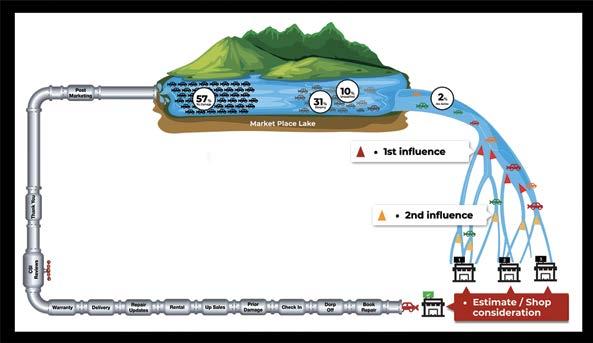


CIECA hosted its latest CIECAST webinar March 30, “How to Adapt to the Speed of Change in the Collision Industry… Without Getting Crushed,” presented by Ryan Taylor, founder of the CRM software BodyShop Booster and president of The AMP Bureau.
Taylor shared three concepts he said are helping some of the great leaders around the world adapt to the speed of change---and are also applicable to anyone in the collision repair space.
The full presentation is available on CIECA’s website at www.cieca.com/ MEETINGS-EVENTS/ciecast-webinars
Taylor said it is important to understand there are different classifications of purchases.
The first is an impulse buy. These come with a high degree of purchase motivation because they are something people really want---like a car or new smartphone—so customers tend to do a lot of research before buying them.
The second, which includes collision repair, is a distress purchase. These have no degree of purchase motivation because people don’t really want it, but need it.
“It’s a very different buying frame of mind,” Taylor said. “You can’t make people research what to do after they’ve had an accident. You can’t create interest in the product by offering discounts if they get in an accident. You can’t build demand by causing accidents.”
In any given market, about 57% of vehicle owners do not have damage and therefore do not need collision repair, Taylor said.
For the other 43%, their buying behavior depends on how much damage their vehicle has. If it’s small, many people will put off getting it fixed for a long time, even years. For those with medium damage, they tend to put it off for a few months. But those with large damage will make the decision to purchase collision repair services within a matter of hours.
“Only about 2% of people are looking for collision repair,” Taylor said. “It fluctuates with conditions [like extreme weather events] but that’s the average.”
Those in the collision repair space need to think about how to “move upstream” in a potential customer’s journey.
“Everyone has a ‘lake,’” Taylor said.
“If you’re a body shop, the lake is the surrounding community; if you’re a supplier, it’s a larger area.”
As customers in the “lake” decide to purchase collision repair services, they “move downstream towards ‘islands
are no longer void when the car is sold, which creates a higher resale value. Shops can show owners how the AMP warranty will increase their car’s Kelley Blue Book value, and owners can show the AMP warranty when selling it.
Taylor said new technology being applied to vehicles can be scary, but the industry should embrace and try to keep up with it.
As an example, he said the U.S. military dedicates 20% of its annual budget to research and development of new technology.
In 1995, Taylor said, there were only four marketing channels---the radio, Yellow Pages, TV and newspaper. Today there are 7,400 different marketing channels.
“Don’t chase the latest marketing craze,” Taylor said. “Focus on the customer.”


Today, people are constantly looking at their phones, but in 1940, in a photo he showed, they were all looking at newspapers.
“The delivery method has changed but human behavior hasn’t, so focus on that,” he said.
Taylor drew a parallel to surfing.
of influence’” that affect their decisions on which shop to use---like insurance companies, OEMs and family and friends, Taylor said.
Beyond that is a second chain of “islands,” like a body shop’s website and social media presence, and the results of a Google search of local shops. These secondary influencers are nowhere near as powerful as the primary ones, Taylor said.
“The average customer looks at three body shops,” Taylor said. “Then they finally make a buying decision.”
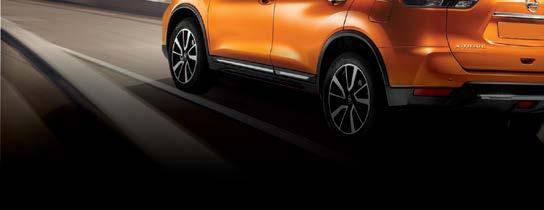
Now that customer is in the “repair tube,” in which they book the repair, drop off the vehicle, pick up their rental vehicle, get repair updates, take delivery and get a warranty, at which point they are “pumped back” into the “lake” as part of the 57% of repaired vehicles that don’t need services.
“Think about how you move upstream in that cycle,” Taylor said.
As an example, Taylor said, he went to dealerships after hail storms to offer dent repair services, but a lot of other repairers were doing the same thing, so he had to “move upstream.”
To do that, he identified dealerships in hail-prone areas, and spoke to the principles at those dealerships about setting up a disaster response plan--before any storm hit, so he was the only one in the room. That way, when a storm did hit, the dealership called him directly to get the response started immediately.
Another example is the AMP Bureau, which helps shops provide nationwide warranties across the U.S. and Canada. This means warranties
“What can you do to start upstream thinking?” Taylor said.
“Inexperienced surfers chase the wave,” Taylor said. “Experienced surfers choose their spot and wait. It looks like they’re not doing much but they are positioned to catch the wave when it comes.”
Concord Kia
Concord
(888) 811-3058
(925) 685-2952 Fax
M-F 8am - 5:30pm
Sat 9am - 1pm
Rosesville Kia
Roseville
(916) 783-8129
(916) 783-1005 Fax
M- F 7am-6pm Sat 8am-4pm
parts@rosevillekia.com
www.rosevillekia.com

AllStar Kia
San Bernardino
(909) 763-4755
(909) 763-4744 Fax
M-F 8am - 6pm Sat 8am - 2pm
parts@allstarkia.net www.allstarkia.net
Car Pros Kia Glendale
Glendale
(818) 745-1103
(818) 244-0017 Fax
M-F 7am - 6pm
duncan@carpros.com
Car Pros Kia Huntington Beach Huntington Beach

(714) 274-6178
(714) 847-4410 Fax
M-F 7am - 6pm Sat 8am - 4pm
jasonr@carpros.com
Citrus Kia Ontario
(800) 583-7042
(909) 390-0948
(909) 390-0982 Fax
scunningham@citrusmotors.com www.citrusmotors.com
M-Sat 7am - 6pm
Free Local Delivery
Ask for Ike, Jimbo, Chris, Juan, Sean, Jeff Se Habla Español
Kearny Mesa Kia
San Diego
(800) 635-6669
(858) 560-5033
(858) 560-9648 Fax
Largest wholesaler in San Diego with 17 delivery trucks
Kia of Alhambra
Alhambra
(626) 289-7803
(626) 289-8807 Fax
kip@kiaofalhambra.com
Kia of Carson Carson
(310) 221-9101
(310) 507-8595 Fax
M-Sat 7am - 7pm Sun 8am - 5pm
www.KiaofCarson.com
Kia of Downtown LA Los Angeles
(213) 342-0923
(213) 342-0980 Fax
M-F 7am - 7pm
www.kiaofdtla.com
Kia of Irvine Irvine
(855) 847-3592
(949) 777-2342 Fax
North County Kia Escondido
(760) 945-9939
(866) 888-3074 Fax parts@autogrp.com www.northcountykia.com

M-F 7am - 6pm In San Diego Over 10 Years
Jim Marsh Kia
Las Vegas
(877) 274-3820
(702) 946-6084 Fax
M-F 8am - 6pm Sat 8am - 2pm
johnd@jimmarshauto.com
Towbin Kia
Henderson
(702) 868-1234
(702) 567-0037 Fax
M-F 7am - 6pm Sat 7am - 4pm
jmoore@towbinkia.com
www.tkwholesale.com
WASHINGTON
Car Pros Kia Renton Renton


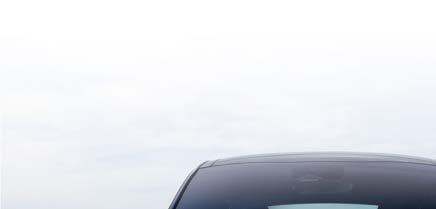

(425) 204-6635
(425) 793-3889 Fax
M-F 7am - 6pm
Sat 8am - 5pm jgaeir@carpros.com
Lee Johnson Kia Kirkland
(425) 823-0188
(425) 284-1790 Fax
M-F 7am - 5:30pm
Sat 7am - 5pm
tthompson@leejohnson.com
*Kia Genuine replacement parts sold but not installed by an Authorized Kia Dealer are covered for 12 months from purchase date, regardless of mileage, for the part only, and any labor charge is the consumer’s responsibility.

Groups of Tesla employees reportedly shared videos and images recorded by customers’ car cameras between 2019 and 2022, according to interviews by Reuters with nine former employees.
The unnamed sources said some of the recordings were highly invasive, with one exemployee describing a video of a man approaching a Tesla vehicle completely naked. Among the videos shared by employees at Tesla’s San Mateo, CA, office via private one-on-one chats were also crashes and road-rage incidents.
According to another exemployee, a crash video from 2021 showed a Tesla driving at high speed in a residential area hitting a child riding a bike. Footage showed the child flying in one direction and the bike in another. The former Tesla employee said the video spread around the office in San Mateo “like wildfire” via the internal messaging system.
Other recordings were more benign, such as photos of dogs and
Hunter Engineering is pleased to announce a new integration between Hunter’s unmanned inspection equipment and Tekion’s end-to-end cloud-native platform, Automotive Retail Cloud (ARC).
With this new partnership, automotive dealerships across North America will have greater opportunity to drive more alignment and tire sales through instant, automated access to inspection data.
As a vehicle passes through Hunter’s unmanned inspection equipment, alignment angles and tire tread depth are instantly measured with laser precision, requiring no labor or stopping. The vehicle inspection data populates in real time in the Tekion platform. The integration is now available for Hunter unmanned inspection customers and carries no monthly equipment fees.
For more information, visit www.hunter.com/connectedequipment/integration-partners
Source: Hunter Engineering
funny road signs that employees turned into memes before posting them in private group chats. According to several ex-employees, some postings were only shared between two employees, but others could be seen by many of them.
Perhaps more worryingly, the computer program employees used at work could show the location of recordings, potentially revealing where a Tesla owner lived, seven former employees told Reuters. That goes against Tesla’s privacy policy, which states “camera recordings remain anonymous and are not linked to you or your vehicle.”
Another potential problem raised by one ex-employee is some videos appeared to have been recorded when cars were parked and turned off. That wouldn’t have been an issue several years ago, when Tesla would receive video recordings from its vehicles even when they were off, provided owners gave consent.
However, Tesla says on its website it stopped doing so for 2018 and newer model year vehicles. These vehicles—with software version 2020.48.5 or newer—store recordings taken in Sentry Mode to

onboard memory. “We could see inside people’s garages and their private properties. Let’s say that a Tesla customer had something in their garage that was distinctive, you know, people would post those kinds of things,” said another former employee. It appears that even CEO Elon Musk fell victim to Tesla cameras’ prying lenses. About three years ago, some employees found and shared a video of a unique submersible vehicle parked inside a garage, according to two people who saw the footage.
That sub was apparently “Wet Nellie,” the white Lotus Esprit that starred in the 1977 James Bond film, “The Spy Who Loved Me.” The vehicle had been bought by Musk for about $968,000 at an auction in 2013. Whether Musk was aware of the video or that it had been shared, it’s not clear.
Of course, Tesla may argue its employees may occasionally need to check out some of the videos coming from customer cars to solve Autopilot issues or simply for data labeling purposes, but the line between that and breaching privacy appears to be very thin.
The Automotive Recyclers Association (ARA) on April 12 announced professional automotive recycler Sean Krause of Speedway Auto, Ltd. in Joliet, IL, has been nominated to join the ARA Executive Committee as secretary for 20232024.
Krause is the CEO of Speedway Auto, Ltd., alongside his father, Paul Krause, who established the business in 1969 with his wife, Indra. In 1991, Krause joined the family business after attending St. Norbert College, where he studied business and finance. During his first weekend out of college, Krause attended an ARA Annual Convention in Chicago at the request of his father, and never imagined how interesting used auto parts were and the many possibilities of recycling automotive parts.
Krause will be formally confirmed by the ARA Board of Directors and Membership during the ARA’s 80th Annual Convention and Exposition, Oct. 12-14 in Kansas City, MO.
To learn more, visit ARA’s home page at www.a-r-a.org or call (571) 208-0428.
New
Alhambra
626-457-2027
Fax
Original BMW Parts & Accessories. MINI of Universal City Universal City 818-452-1219
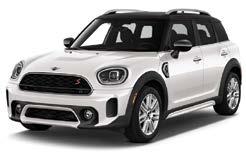

818-432-5819
818-769-1520
M-F 8am-6pm Sat 8am-5pm
There were 42,939 people killed in motor vehicle traffic crashes on U.S. roadways during 2021—the largest number of fatalities since 2005 and a 10% increase from 2020, according to a report released April 3 by the National Highway Traffic Safety Administration.
Among the report’s key findings:
• Fatalities and people injured increased in most categories.
• Speeding-related fatalities increased by 7.9%, alcoholimpaired-driving fatalities increased by 14% and seat belt non-use fatalities increased by 8.1%.
• Urban fatalities increased by 14%; rural fatalities increased by 4.7%.
• Female fatalities increased by 12%, and male fatalities increased by 9.2%.
• Nighttime (6 p.m. to 5:59 a.m.) fatalities increased by 11%; daytime (6 a.m. to 5:59 p.m.) traffic fatalities increased by 9.7%.
• Forty-three states, Washington, D.C., and Puerto Rico had
fatalities.
The fatality rate per 100 million vehicle miles traveled (VMT) increased by 2.2% from 1.34 in 2020 to 1.37 in 2021.
The estimated number of people injured on U.S. roadways increased in 2021 to 2.5 million, rising from 2.28 million in 2020, an increase of 9.%. The injury rate per 100 million VMT increased by 1.3% from 79 in 2020 to 80 in 2021.
The estimated number of police-reported traffic crashes increased from 5.25 million in 2020 to 6.10 million in 2021, a 16% increase.
Total VMT increased by 8.1% from 2,904 billion in 2020 to 3,140 billion in 2021. Overall, the monthly VMT for 2019 and 2021 are similar in pattern; the monthly VMTs for 2020 were different with vehicular travel declines in response to the COVID-19 pandemic.
The proportion of people killed “outside the vehicle” (motorcyclists, pedestrians, pedalcyclists and other
from a low of 20% in 1996 to a high of 34% in 2021. Correspondingly, the proportion of people killed “inside the vehicle” (occupants of passenger cars, light trucks, large trucks, buses and other vehicles) has declined from a high of 80% in 1996 to 66% in 2021.
The number of pedestrian fatalities has been outpacing the number of motorcyclist fatalities since 2013. Both pedestrian and motorcyclist fatalities have been rapidly rising in recent years. In 2021, the number of motorcyclists killed—5,932—was the highest since the data began being tracked in 1975, and a 7.7% increase from 2020. The number of pedestrians killed in 2021— 7,388—was a 13% increase from 2020.
Based on the data, NHTSA’s three major behavioral focus areas are speeding, alcoholimpaired driving and seat belt non-use. These factors explain some traffic fatality increases from 2020 to 2021, although the NHTSA cannot say they were the only ones contributing to the rise.
Source: NHTSA

CCC Intelligent Solutions Inc. has been recognized by Business Intelligence with two Artificial Intelligence (AI) Excellence Awards.
The 2023 AI Excellence Awards recognize organizations, products and people applying AI to solve real business challenges.
CCC’s estimating solution CCC® Estimate-STP was recognized as a top innovation in the product category for 2023. CCC Estimate-STP uses advanced AI and insurer-driven rules to automatically initiate and populate detailed and actionable estimates for qualified repairable estimates in seconds without the need for human intervention.
In the organization category, CCC’s NXT Lab innovation hub was recognized as a center of excellence for its work across internal teams, including data science, R&D, engineering, support and design, to develop and test next-generation AI solutions for the industry.
Source: CCC Intelligent Solutions, Inc.
Eastside Subaru

Kirkland
(425) 820-1676
Mon.-Fri. 7-4 ldarwin@eastsidesubaru.com
parts@subarusb.com www.sbsubaru.com
Elk Grove Subaru Elk Grove
(877) 475-0659
(916) 509-8559 Fax
Mon.-Fri. 8-6 shawnh@elkgrovesubaru.com www.elkgrovesubaru.com

Santa Cruz Subaru
Santa Cruz
(888) 844-7131
(831) 420-1402
(831) 420-1923 Fax
Mon.-Fri. 7:30-6; Sat. 8-5 parts@santacruzsubaru.com www.santacruzsubaru.com
Kendall Subaru of Marysville
Marysville
Parts Hotline (866) 662-2819 (360) 716-2553 24 Hr Fax Mon.-Fri. 7-6; Sat. 8-4:30 wholesaleparts@kendallauto.com scotteney@kendallauto.com
www.kendallsubarumarysville.com

A nearly two-year trend was broken in March when the average price Americans paid for a new vehicle fell below the manufacturer’s suggested retail price (MSRP) for the first time in 20 months, according to data released April 11 by Kelley Blue Book, a Cox Automotive company.
The average transaction price (ATP) of a new vehicle in the U.S. declined in March to $48,008, a month-over-month decrease of 1.1% ($550) from a downwardly revised February reading of $48,558. March transaction prices remained up 3.8% ($1,784) compared to year-ago levels.
Meanwhile, auto manufacturers’ incentive spend rose to the highest level in 11 months at 3.3% of the ATP in March, averaging $1,516.
According to Kelley Blue Book calculations, new-vehicle ATPs have been above the average MSRP--also known as the sticker price--for 20 months, but March brought long-awaited good news for buyers as that trend finally changed. In March, transaction prices continued to trend downward and the average price consumers paid fell to $171 below the average sticker. For comparison, a year ago in March 2022, the average ATP was nearly $1,000 over MSRP.
Sales volumes were up month over month by 20% and up 8% year over year in March, thanks partly to improved supply, a better mix of lower-priced models and strong fleet sales.
“The latest transaction data from March reveals new-vehicle prices continued a downward trend through the first quarter of 2023,” said Rebecca Rydzewski, research manager of economic and industry insights for Cox Automotive. “Both luxury and non-luxury prices were down month over month. We’ve been anticipating transaction price declines, as inventory has been steadily improving and choice has expanded. More vehicles on dealer lots---and on their competitors’ lots---means dealers simply don’t have the pricing power they did six months ago.”
The average price paid for a new non-luxury vehicle in March was $44,182, a decline of $505 compared to February. Most nonluxury brands---including Chevrolet, Chrysler, Dodge, Ford, Hyundai, Kia, Nissan and Volkswagen---saw ATP declines between 0.2% to 3.8%
month over month in March. This correlates with higher incentives helping to push prices down.
Honda and Kia showed the most price strength in the non-luxury market, transacting between 3% and 6% over sticker price in March.
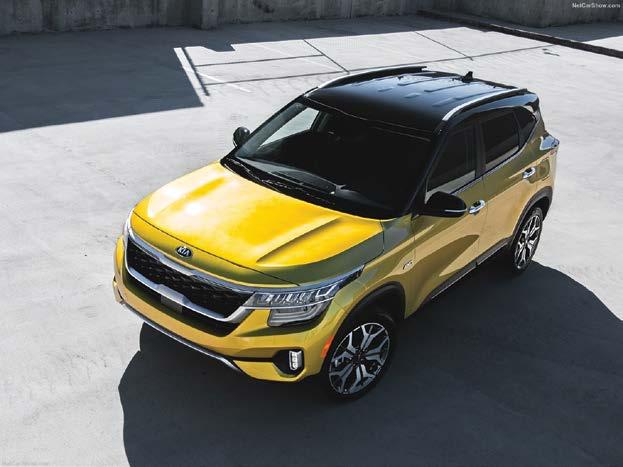
March compared to February. The average new EV sold for $58,940 in March, according to Kelley Blue Book estimates, which still is well above the industry average. New EV pricing peaked in 2022, coming down steadily since Q3 of last year.
same time, offsetting lower-priced Tesla products.
Strong luxury vehicle sales have been a primary reason for overall elevated new-vehicle prices. This trend continued in March when luxury vehicle share hit 18.2% of total sales, down slightly from a high of 19.5% in February.
The high share of luxury sales continues to push overall industry ATP higher, even though the luxury ATP has declined month over month. For comparison, in March 2018, the luxury share was 14.0% of the market.
Two luxury brands now have average transaction prices over $100,000---Land Rover and Porsche. (Note: Kelley Blue Book data presented here does not include exotic brands such as Ferrari and Rolls Royce.)
Buyers continue to pay over MSRP for new luxury vehicles. In March, the average luxury buyer paid $65,202 for a new vehicle, down just $9 from February. Luxury vehicle ATPs were a mixed bag in March, with entry-level luxury cars, high-end luxury cars, luxury compact SUVs, luxury mid-size SUVs and luxury subcompact SUVs all showing price declines between 0.5% and 1.4%. Luxury cars and luxury full-size SUVs saw price increases between 0.8% and 1.6%.
The average price paid for a new EV increased by $313 (up 0.5%) in
Still, March’s upward movement of EV ATP was a bit of a surprise, since Tesla, the automaker with the largest share of EV sales, has cut prices three times in recent months. However, EV sales from Mercedes-Benz, Rivian, Lucid and other brands have increased at the
are
Incentives averaged $1,516, increasing to 3.2% of the average transaction price compared to 3.0% in February. However, incentive spend remains at a historically low level.
For comparison, two years ago in March 2021, Kelley Blue Book estimated incentives averaged 8.4% of ATP. Luxury cars had the highest incentives in March 2023 at 6.7% of ATP. Meanwhile, vans had the lowest incentives at less than 1% of ATP.
“Incentives and inventory tend to move in tandem—when one moves up, so does the other,” said Rydzewski. “Right now, in-market consumers are finding more inventory, more choice and dealers more willing to deal, at least with some brands. Yet, even as deals improve, unfortunately auto loan rates remain very high, ultimately making new-vehicle affordability an issue for many households.”
Source: Kelley Blue Book
DOWNEY NISSAN
Downey
562-334-1188
(562) 334-1195 Fax
M-F 7-5
wholesaleparts@downeynissan com
MOSSY NISSAN
ESCONDIDO
Escondido
888-292-0402
(760) 746-4300
(760) 739-5794 Fax
M-F 7:30-5
mikebe@mossy com
RonH2@mossy com
NISSAN OF BAKERSFIELD
Bakersfield
888-402-6915
(661) 835-0389 Fax
M-F 7-6, Sat. 8-5
www nissanofbakersfield com
NISSAN OF VAN NUYS
Van Nuys
818-374-4421
(818) 787-8400
(818) 908-9520 Fax
M-F 7-6:30, Sat. 7-6
wholesaleparts@vannuysnissan�com
www nissanofvannuysparts com
TEMECULA NISSAN
Temecula
951-972-8430
(951) 972-8396 Fax
M-F 7-6, Sat. 7-6, Sun. 8-5
wholesaleparts@temeculanissan com

INFINITI

INFINITI OF VAN NUYS
Van Nuys
818-374-4493
(818) 787-8400
(818) 809-2727 Fax
M-Sat. 8-5
wholesaleparts@vannuysinfiniti com
www infinitiofvannuys com
GOLDEN STATE NISSAN Colma
650-488-2873
(650) 944-0305 Fax
M-F 7-6
parts@goldenstatenissan com
FUTURE NISSAN

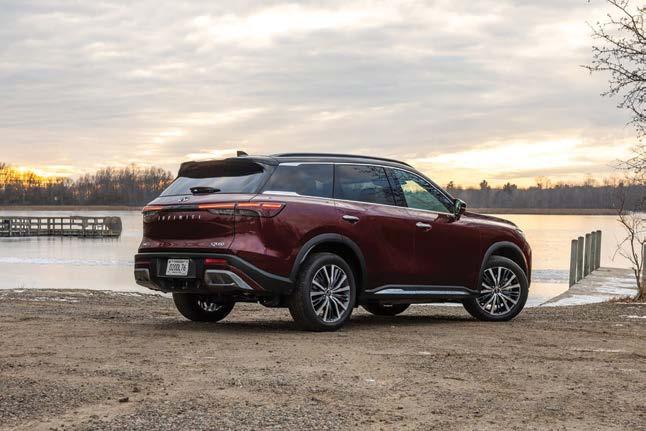
Roseville
916-677-5251

(916) 786-0743 Fax
M-Sat. 7:30-6
wholesale@futurenissan com
Parts FutureNissan com
MOSSY INFINITI OF ESCONDIDO
Escondido
888-292-0402
(760) 746-4300
(760) 739-5794 Fax
M-F 7:30-5
mikebe@mossy com
RonH2@mossy�com
GOLDEN STATE INFINITI Colma
650-488-2877
M-F 7-6
parts@goldenstatenissan com

We at Collision Advice recently reviewed some data on the average collision repair severity in each state, and not surprisingly, it has continued to rise. On a national basis, it’s now over $4,700, but in many states, the average is over $5,000, and there’s one state where the average is over $6,000.

has risen by about $1,000 since 2019 in some states, and by as much as $2,000 in others. But more interestingly, the actual number of labor hours per job hasn’t risen that much.
In some states, the average total number of labor hours is up by only about 1.2 hours over that four-year period. The biggest increase we saw in the average number of labor hours per job in any state was four hours.
In some cases, when the labor hours were broken down by type— body, refinish, frame and mechanical— we actually saw some small decreases in the averages in some state.
Insurance companies are really just hammering shops and trying to control severity.
While that may be true to an extent, I believe that a majority of shops—and I’m not trying to offend anybody here—use the insurance companies as an excuse for their own
we’re not giving them the time to write a proper damage analysis.
In some cases, we have people who are not educated themselves teaching someone else. It’s kind of like that game of telephone we all played in school, where one person tells another person something, and that person is supposed to tell another person the exact same thing, and so on, but by the time the message gets to the last person, it’s very different than the original.
But we wanted to drill down further to look not only at how average severity has changed over the past five years, but also how average number of labor hours per job have changed over that time.
Again, looking at the data on a state-by-state basis, average severity
So at the end of the day, severity has gone up, but it’s not because of a significant increase in the labor hours per job. The increase is more based on increased scans and calibrations, and because of the use of more—and more expensive—parts per job.
As I looked at this data, I started to ask myself why. If you asked me this three or four years ago, I would have said maybe it’s insurance pressure.
lack of knowledge and training. I really believe we have people in shops writing estimates or repair plans who have not been properly trained.
Part of the reason: We’re having to hire a lot of new people in our industry, and I think too often we’re not setting them up for success. We’re not giving them the time to train, we’re not finding the right training, and then
Now my company offers estimating training, but there’s a lot of others sources of estimate training as well. You have Dave Dunn at Masters School. You have Kristen Felder and Larry Montanez with Collision Hub. You have Roger Cada from Accountable Estimating.
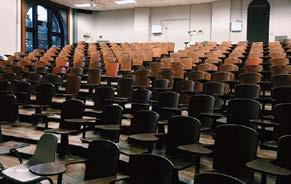
So I’m not saying you need to get training from us. I’m just saying you need to find somebody that can help get your team properly trained. I think it’s only going to become even more important as we start working on more and more electric vehicles.

“So at the end of the day, severity has gone up, but it’s not because of a significant increase in the labor hours per job.”
— MIKE ANDERSON COLLISION ADVICE
The CAR (Consumer Access to Repair) Coalition, a growing group of independent automotive parts and repair companies, associations and insurers committed to preserving consumer choice and affordable vehicle repair, is commending a bipartisan letter from 28 state attorneys general urging lawmakers to approve bipartisan legislation protecting consumer rights in the post-collision auto repair market.
Specifically, the attorneys general are urging key members of Congress to advance the SMART and REPAIR Acts, which have recently been reintroduced in the 118th Congress.
“We applaud the bipartisan group of attorneys general for urging Congress to pass commonsense right to repair legislation, like the recently reintroduced SMART and REPAIR Acts,” CAR Coalition Executive Director Justin Rzepka said. “These attorneys general, as chief consumer protection and antitrust enforcers, are well aware of the pressure of rising prices on the people in their states. Swift federal
legislation is critical to protecting consumers’ right to repair the products they purchase—restoring choice to the repair process, increasing competition and lowering costs.”
The letter states in part: “The Right to Repair is a bipartisan issue that impacts every consumer, household and farm in a time of increasing inflation. It is about ensuring that consumers have choices as to who, where, when and at what cost their vehicles can be repaired. It is about ensuring small automobile businesses and ‘mom-and-pop’ auto shops can remain competitive against a closed system favored by original equipment manufacturers (OEMs).”
The letter can be read in full at carcoalition.com/wp-content/ uploads/2020/07/Right-to-RepairLtr.-to-Congress-FINAL.pdf
The Save Money on Auto Repair Transportation SMART Act (H.R. 1707) will put an end to automakers’ unfair use of patents by reducing from 15 years to 2.5 years the time that automakers can enforce design
patents against alternative parts manufacturers on collision repair parts, including common parts like side mirrors, quarter panels and bumpers. The Right to Equitable and Professional Auto Industry Repair (REPAIR) Act (H.R. 906) will ensure consumers have access to their car’s data and the repair tools needed to maintain modern cars.
The introduction of the SMART and REPAIR Acts builds on growing momentum for the consumer protections in the post-collision repair market, including endorsements from the White House and Federal Trade Commission, along with an unprecedented show of support from federal lawmakers in the FY2023 government funding package and spotlights at two congressional hearings.
According to recent research from the CAR Coalition and DePaul University College of Law, anti-competitive practices from automakers cost American consumers more than $1.5 billion per year in higher auto repairs.
Source: CAR Coalition
General Motors celebrated its top global suppliers during its annual Supplier of the Year event held in San Antonio, TX.
In total, 121 suppliers were recognized at the event, with 105 suppliers receiving a Supplier of the Year award, 14 suppliers receiving an Overdrive award and two suppliers receiving both Supplier of the Year and Overdrive awards. Collectively, the awarded suppliers represented 17 countries.
The honorees for 2022 include six certified diverse suppliers recognized as a Supplier of the Year. GM was the first automotive OEM to establish a supplier diversity program in 1968. Over the past five years, GM has spent more than $18 billion and contributed to many community initiatives in collaboration with diverse suppliers. GM strives to achieve equitable and sustainable supply chain inclusion goals to help establish long-term viability for the company’s diverse supply base.
Source: GM
Galpin Volkswagen North Hills 888 840-8416


Fax: 818-778-2090 www.galpin.com
Volkswagen Pasadena Pasadena 626-577-0300
866-654-8591
Fax: 626-568-0387
M-F 7:30am-6pm; Sat
Niello Volkswagen Sacramento 916-482-5790
Fax: 916-481-9579
Mon-Sat 8am-5pm vw.parts@niello.com


WASHINGTON
University Volkswagen Seattle
206-634-8200
Fax: 206-547-1581
M-F 7am-6pm
parts@uvwaudi.com www.universityvw.com
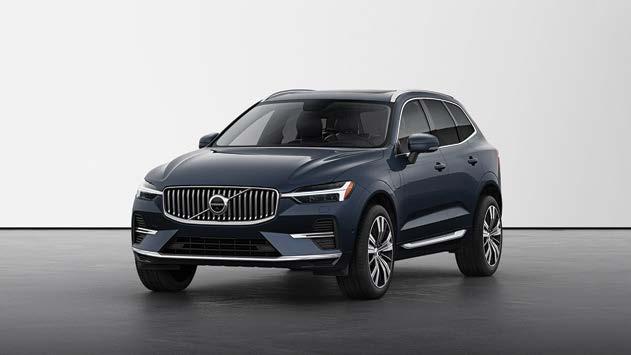
A car’s make and model play a major role in how much drivers pay for auto insurance. Certain vehicles are deemed more of a risk to insure, which can raise the cost of the insurance policy.
The Guides Auto Team recently determined the 10 most expensive car makes to insure along with why they have high average premiums, as well as the cheapest car makes to insure.
While Dodge is one of America’s oldest automakers, it’s mainly known today for offering cars packed with power and speed. Partly due to this, the Insurance Institute for Highway Safety (IIHS) found the Dodge Charger’s insurance losses are about 110% higher than average, with other Dodge models following closely behind. When taken
expensive make to insure. While both the Lexus ES 350 and the Lexus IS were 2022 Top Safety Pick+ winners from the IIHS, this luxury brand’s car insurance rates aren’t cheap. The average cost to insure a Lexus is $189 per month or $2,273 per year.
5. GMC
GMC is a division of General Motors (GM) that manufactures trucks and other utility vehicles. As the fifth most expensive vehicle make to insure, the average cost for auto insurance on a 2022 GMC model is $184 per month or $2,207 per year.
6. Ram
A subset of Fiat Chrysler Automobiles (FCA), Ram is well-known for its heavy-duty pickup trucks. The IIHS found pickup trucks and SUVs are proportionally more likely than cars to be involved in fatal single-vehicle crashes such as rollovers. The risks associated with protecting pickup trucks could factor into the cost of auto insurance for Ram models, which is $175 per month or $2,101 per year.
models like the speedy Nissan GT-R and the all-electric Nissan Leaf, the average cost of auto insurance for a 2022 Nissan is around $167 per month or $2,004 per year.
8. Hyundai Hyundai is a well-known and popular South Korean automaker. Unfortunately, the Highway Loss Data Institute (HLDI) found vehicles built by Hyundai and Kia are often top targets of car thieves, with theft claims twice as common as with all other manufacturers combined. The average cost of auto insurance for a 2022 Hyundai is $164 per month or $1,973 per year.
9. Kia
Another leading car brand from South Korea, the HLDI found Kia models are top targets of auto theft as well. Many 2015 to 2019 Hyundai and Kia models lack electronic immobilizers, which prevent thieves from starting a car without the proper key. Average costs for auto insurance for 2022 Kia models amount to $164 per month or $1,968 per year.
While auto insurers consider many factors when setting auto insurance rates, a car’s make and model are some of the most important. From typical repair costs to the number of liability claims filed, it may be surprising how much car choice affects auto insurance costs.
There are various factors that can make a vehicle expensive to insure. For example, auto insurance providers might consider drivers more likely to get into an accident or receive a speeding ticket if they have a car with a powerful engine.
The chosen trim level can also have a major effect on how much a driver gets charged for car insurance. A new car with high-tech features will cost more to repair or replace, so auto insurers may require higher rates to cover these potential expenses.
In addition, drivers will likely face a hefty insurance bill if they own a luxury or high-performance car like the Porsche Panamera, Maserati Quattroporte, Audi R8 or MercedesBenz AMG GT.

The Guides Auto Team ranked the 10 most expensive cars to insure using data from Quadrant Information Services.
together, Dodge models are the most expensive cars to insure among the leading brands in the U.S.

The average cost to insure a 2022 Dodge model is $354 per month or $4,242 per year. That’s about 145% higher than the national average for a full-coverage auto policy, currently $144 per month or $1,730 per year.
2. Tesla Tesla is one of the most well-known electric vehicle (EV) manufacturers on the market today. However, the IIHS found models such as the Tesla Model X are expensive to repair after collisions, which partly explains why they’re pricey to insure. Since EV models use parts that are tough to find and often expensive, it’s not surprising Teslas have high insurance rates.
The national average cost to insure a 2022 Tesla model is $251 per month or $3,007 per year. That’s almost a 74% increase from the national average cost for full-coverage auto insurance.
3. BMW
The average cost to insure a BMW is $195 per month or $2,337 per year, which is 35% higher than the national average. BMW is known as a luxury car brand, so this high insurance cost may come as little surprise. Higher-end models and luxury vehicles cost more to insure overall.
4. Lexus Lexus ranks as the fourth most
7. Nissan
10. Toyota
No. California
American Chevrolet MODESTO
209-491-7810
209-575-2564 Fax
M-F 7:30 am - 5:30 pm Sat 9 am - 2 pm gmparts@americanchevrolet.com www.americanchevrolet.com
Blackstone Chevrolet Wholesale Parts FRESNO

559-438-5875
559-438-4345 Fax
M-F 7:30am – 5:30pm Sat 8am – 4:30pm bharman@blackstonegm.com
Chase Chevrolet STOCKTON
209-475-6620
209-475-6708 Fax
M-F 7am - 5pm Sat 7:30am-4:30pm cesar@chasechevrolet.com
Dublin Chevrolet Cadillac Buick GMC DUBLIN
925-828-8251
925-829-2941 Fax
M-F 7am - 6pm dublinchevyparts@cacargroup.com www.dublinchevrolet.com
No. California
FH Dailey GM Parts Center SAN LEANDRO
800-4A-GMPART
510-351-0534
M-F 8 am - 5 pm Sat 8 am - 4 pm parts@fhdailey.com www.fhdailey.com
Michael Stead Cadillac WALNUT CREEK
925-934-5022
925-934-0336 Fax
M-F 8 am - 5 pm Sat 8 am - 3 pm steadparts@gmail.com
Courtesy Chevrolet SAN DIEGO
800-336-1404
619-297-4023 Fax
M-F 7am - 6pm Sat 8am - 5pm www.courtesysandiego.com
Paradise Chevrolet VENTURA
888-5-CHEVY-5
(888-524-3895)
805-642-0134
805-644-7214 Fax
M-F 7:30am - 6pm Sat 8am - 3pm
So. California
Rydell Automotive Group SAN FERNANDO VALLEY
818-832-1660
818-832-1692 Fax
M-F 6am - 7pm Sat 8am - 5pm nrparts@rydells.com
Thorson Motor Center PASADENA
626-793-0454
626-795-6872 Fax
M-F 7:30am - 6pm Sat 8:30am - 2pm parts@thorsonmotorcenter.com
Denny Menholt Chevrolet BILLINGS
406-896-3111
406-896-3924 Fax
M-F 7 am - 6 pm tsoltis@dennymenholt.com
Nevada
Corwin Buick GMC RENO 775-333-8777
775-322-1837 Fax
M-F 8am - 5:30pm ahardie@corwinauto.com www.corwinbuickgmc.com
Michael Hohl Motor Company CARSON CITY 775-884-8619

775-884-8645 Fax
M-F 7 am - 6 pm Sat 8 am - 5 pm gmparts@michaelhohl.com
Ford’s vehicles, commercial and EVs drove a first-quarter sales increase of 10.7%, making the Blue Oval America’s best-selling brand.
Sales surged across Ford’s areas of strength, including trucks (up 19.6%); three-row SUVs (up 47.6%); Bronco brand (up 18.3%); Ford Pro Transit van (up 86%); Mustang (up 5.2%) and electric vehicles (up 41%).
2022 (43,322). SOA also reported year-to-date sales of 143,376, an 8.3% increase compared to Q1 2022. March marked the eighth consecutive month of month-over-month sales increases for the automaker.
In March, Crosstrek was the top performer by volume and achieved its best March ever with 14,040 vehicle sales. WRX sales for March increased 1,373 percent over the same month in 2022, while Impreza posted a 63.3% increase. Forester sales for March increased 56.2%, and Ascent sales increased 43.2% compared to March 2022. In addition, 513 of the all-electric Solterra SUV were delivered in March.
Toyota
were only constrained by a shortage of new vehicle inventory.
Mazda
Mazda North American Operations (MNAO) reported total March sales of 34,778 vehicles, an increase of 5.3% compared to March 2022. Year-todate sales totaled 88,384 vehicles, an increase of 7.4% compared to the same time last year. With 27 selling days in March, compared to the same the year prior, the company posted an increase of 5.3% on a Daily Selling Rate (DSR) basis.


CPO sales totaled 5,309 vehicles in March, an increase of 20% compared to March 2022.
In the first quarter, Hyundai total sales were 184,449 units, a Q1 total sales record and an increase of 16% year-over-year. Q1 retail sales were 169,491 a 6% increase compared with Q1 2022. Hyundai also set new Q1 total and retail sales records for Venue, Elantra N, Santa Fe HEV, Tucson, Tucson HEV, Santa Cruz and Kona EV.
Kia
Building on 2022’s best-ever market share achievement, Kia America opened 2023 with a record first quarter of 184,136 units, a 15% increase over the previous high set in 2021.
Ford’s overall vehicle sales—Ford Blue, Ford Pro, Model e and Lincoln— totaled 475,906, up 10.1% with estimated share up over a year ago.
Ford’s EV sales grew 41% in the first quarter on sales of 10,866 electric vehicles. F-150 Lightning sales totaled 4,291 pickups with production capacity actions on track to hit an annual production run rate of 150,000 this year. Sales by Ford Pro of the E-Transit, America’s best-selling electric van last year, climbed 62.7%. Reflecting downtime at the plant for changes to increase production, Mustang Mach-E sales were down.
Ford is America’s No. 1 selling truck manufacturer, with 254,023 trucks and vans sold in the first quarter, outselling GM’s trucks and vans by approximately 27,000 vehicles. Sales of Ford’s overall trucks, including pickups and vans, were up 19.6% on the strength of F-Series pickups (up 21.1%) and Ford Pro’s Transit van (up 86%).
To support this momentum, Ford’s Kansas City Assembly Plant will add a third crew in April to increase production for Ford Pro of the bestselling Transit and E-Transit vans. Ford also is increasing production at manufacturing plants across North America to meet strong customer demand for vehicles including Mustang Mach-E, F-150 Lightning, Bronco Sport and Maverick.
Ford Explorer was the best-selling three-row midsize SUV in America, and the red-hot Bronco brand saw sales growth of 18.3%, including a 37.6% rise for Bronco. Additionally, Expedition sales surged.
Subaru Subaru of America, Inc. reported 53,213 vehicle sales for March, a 22.8% increase compared with March
Toyota Motor North America (TMNA) reported March U.S. sales of 176,456 vehicles, down 9.1% on a volume and daily selling rate (DSR) basis versus March 2022. Sales of electrified vehicles for the month represented 27.5% of total sales volume.
For the first quarter, TMNA reported sales of 469,558 vehicles, down 8.8% on a volume and DSR basis versus March 2022. Sales of electrified vehicles for the first quarter totaled 118,836, representing 25.3% of total sales volume.
Toyota division posted March sales of 150,099 vehicles, down 12% on a volume and DSR basis. For the quarter, Toyota division reported sales of 401,306 vehicles, down 10.9% on a volume and DSR basis.
Lexus division posted March sales of 26,357 vehicles, up 12.1% on a volume and DSR basis. For the quarter, Lexus division reported sales of 68,252 vehicles, up 6% on a volume and DSR basis.
Mitsubishi
Mitsubishi Motors North America (MMNA) reported first quarter 2023 sales, with the brand’s all-new 2023 Outlander Plug-in Hybrid Electric Vehicle (PHEV) setting all-time monthly and quarterly sales records for the nameplate, up more than 104% and 122% over the same month and quarter, respectively, of the previous year.
MMNA’s overall Q1 sales totaled 20,938, down about 20% as demand continued to outstrip supply. Outlander PHEV’s gasolinepowered sibling continues to be the brand’s best-selling model, as it has been since the launch of this generation vehicle. Backing up Outlander in volume was its smaller sibling, Outlander Sport, showing an increase across the quarter of more than 24% year-over-year versus Q1 2022. Overall sales for the quarter

Hyundai
Hyundai Motor America reported total March sales of 75,404 units, a 27% increase compared with March 2022 and the best March in Hyundai history.

This was the fifth consecutive month with a total monthly sales record, led by Venue (+74%), Elantra HEV (+37%), Tucson HEV (+52%), and Kona N (+5%).
March was an all-time best-ever retail and total sales record for Santa Cruz (+30%) and Santa Fe HEV (+123%). Hyundai fleet sales were 9.4% of total volume for the month.
Kia’s March total of 71,294 marked the second-highest monthly performance in company history and was the eighth consecutive month of record-breaking sales. March sales were up 19.8% over the same period last year and up 7% over the previous March record.
In addition, four Kia models— Carnival up 81%, Sportage up 37%, Telluride up 23%, Forte up 14%---achieved best-ever March totals while the brand’s electrified models increased 10% over the same period last year.
Source: Ford, Subaru, Toyota, Mazda, Mitsubishi, Hyundai, Kia
Ford Motor Company Fund, the company’s philanthropic arm, is joining Ford dealers across four U.S. regions—Atlanta, Chicago, Dallas and Phoenix—to provide a million dollars in scholarship funding to help students pursue careers as automotive technicians.
The auto industry has long faced a shortage of technicians due to fewer students entering and graduating from postsecondary programs, according to TechForce Foundation. Despite annual demand for 258,000 new technicians, there are only 48,000 graduates from technician programs each year nationwide.

The gap is likely to widen over the next decade without new graduates as there are projected growth rates of 14% in Arizona, 10% in Texas, 7% in Georgia and 3% in Illinois for this career field respectively.
“As we move toward an electrified future, these career opportunities are exciting and require skilled technicians who are proficient in STEM-related study,” said Elena Ford, chief customer experience officer. “Working

together with the Ford Fund and our dealers to offer this scholarship program means we will welcome a new generation of diverse students to the industry, and hopefully into our Ford family, to help us better serve our customers.”
student’s school tuition account and may be used for all cost of attendance, including tuition, tools, living expenses and transportation.
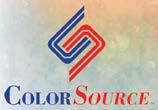




“These scholarships will go a long way in engaging students, particularly those from underresourced communities, to consider careers in automotive technology and service,” said Jennifer Maher, CEO, TechForce Foundation. “We’re excited about working with the Ford Fund and Ford dealer partners to help create a path to careers students may not have considered before.”
and expertise of the essential skills required to build a diverse pipeline of auto technicians.

This program supports Ford’s greater mission to prepare, empower and grow the future workforce needed to service vehicles and customers to prepare for an electrified future including:
A focus on STEM-based curriculum in combination with hands-on learning

Reaching students early and reinforcing the opportunities available for upward professional and economic advancement
Collaboration with dealers through their involvement in participating schools, career fairs, shadowing days, mentoring and internships
The Ford Auto Tech Scholarship is open to current and future students who are enrolled in postsecondary auto or auto and diesel technician training programs in the Greater Atlanta, Chicago, Dallas and Phoenix areas. This needbased scholarship is applied to a

Scholarships will be administered by TechForce Foundation, a national nonprofit supporting students to and through their education and into careers as professional technicians. Ford is proud to partner with TechForce given their deep understanding
For more information and to apply for the Ford Auto Tech Scholarship opportunity, students can visit www.TechForce.org/ FordFund.
Applications are due by June 30, and applicants will be notified of the results on a rolling basis throughout the spring and summer.
Source: TechForce Foundation



In a letter to the NHTSA, Ford announced it is abandoning its petition that would allow it to operate autonomous vehicles without physical human controls.
Autonomous vehicle technology has grown in popularity since the launch of Tesla’s suite of autonomous driving offerings. Now, countless automakers, including Mercedes-Benz, General Motors and Ford, have all jumped on the technology as a new revenue stream, but many are learning it isn’t as easy as it looks.
Ford most recently was forced to abandon its self-driving joint venture with Volkswagen, and now, according to Reuters, it is further distancing itself from the technology it once explored.
More specifically, Ford announced it will no longer pursue a petition to operate autonomous vehicles without human controls. This technology was initially meant to be implemented as part of its joint venture with Volkswagen, Argo AI, but with the abandoning of the
project, Ford is no longer looking to do so.
Ford’s letter to the NHTSA said autonomous vehicles and their implementation will be a significant challenge, especially as the automaker looks to turn the technology into a business model of its own. “As evidenced by the planned shutdown of our ADS partner Argo AI, we believe the road to fully autonomous vehicles, at scale, with a profitable business model, will be a long one,” Ford said.

Ford initially planned for Argo AI to be a delivery and ride-hailing competitor, similar to the Cruise subsidiary established by General Motors. GM is still pursuing a similar petition with the NHTSA to operate vehicles without physical human controls.
This isn’t to say Ford is abandoning autonomous driving as a whole; far from it. Ford is continuing to grow the number of vehicles it is equipping with its BlueCruise level 2 self-driving technology, and the Blue Oval has even established a new AV subsidiary, but without the help of VW Group.
After nine strong model years in the market, with hundreds of thousands sold, the sixth generation Chevrolet Camaro will retire at the conclusion of model year 2024.
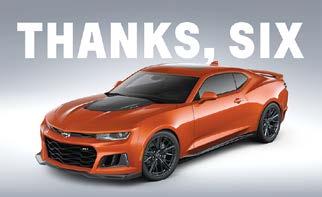
The final sixth generation Camaros will come off the assembly line at the Lansing Grand River Assembly Plant in Michigan in January 2024.
ultimate street-legal track Camaro, the 650-horsepower ZL1 1LE, produced the fastest time for any Camaro around GM’s Milford Road Course at the company’s Milford Proving Ground in Michigan.
Whether it is picking up awards for on-road performance, or race wins and championships at tracks across the world, Camaro has demonstrated Chevrolet’s ability to win in the most demanding environments.
Edition pays homage to Camaro, resurfacing ties that date back to the development of the first generation Camaro in the 1960s, most notably the program’s initial code name: Panther.
More information on the 2024 Camaro line and Collector’s Edition package will be available closer to the start of orders this summer.
Motorsports
Hunter Engineering’s popular ACE on-car brake lathe with tablet now also connects with the HunterNet® 2 platform.
HunterNet ® 2 is a free customer portal developed for undercar service operators with single or multiple rooftops, allowing operators to access actionable performance data for all their Hunter-connected equipment.

Available in coupe and softtop convertible variants, this latest generation Camaro is known for supreme athleticism and composure. Magnetic Ride Control became available on the Camaro SS in the sixth generation and track-focused 1LE packages proliferated through all levels of the lineup for the first time. The
“As we prepare to say goodbye to the current generation Camaro, it is difficult to overstate our gratitude to every Camaro customer, Camaro assembly line employee and race fan,” said Scott Bell, vice president, Global Chevrolet. “While we are not announcing an immediate successor today, rest assured, this is not the end of Camaro’s story.”
Chevrolet will celebrate this storied nameplate with the addition of the Collector’s Edition package on the 2024 Camaro RS and SS, and on a limited number of ZL1 equipped vehicles available in North America. The Collector’s
The Center Square
Attorneys general from 23 states on March 20 sent a letter to Kia and Hyundai pressing them for solutions related to their cars that keep getting stolen. “Alarmingly high rates of theft of these vehicles have been sustained over a long period of time. Your consumers continue to be harmed as a result, and worse yet, the thefts contribute to an erosion of public safety as they are frequently accompanied by reckless driving and the commission of other crimes, further endangering our communities,” the letter states. “While your companies are reported to have taken some steps to address this crisis, it hasn’t been enough, and it hasn’t been done fast enough.”
Thieves have figured out a way to start some Kia and Hyundai models without a key. The letter states the software upgrade from Kia and Hyundai is a start, but it is late and not enough. “The recent announcement of a customer service campaign— not a recall—which combines warning stickers, longer alarms
and a software upgrade, is positive news but less than is called for under the circumstances,” the attorneys general wrote. “Our concerns with the adequacy of the newly announced measures are informed by your companies’ slow response and lack of acceptance of responsibility for the crisis over the past few years.” Kaul and the other attorneys general want Kia and Hyundai to provide steering wheel locks. “Kia and Hyundai need to step up to address the scourge of theft of vehicles they manufactured without anti-theft immobilizers,” Wisconsin Attorney General Josh Kaul said. “These companies must act swiftly to reduce further harm from the high rates of theft of Kias and Hyundais.”
In addition to Wisconsin, attorneys general from Arizona, California, Colorado, Connecticut, District of Columbia, Delaware, Illinois, Massachusetts, Maryland, Nevada, New Jersey, New Mexico, New York, North Carolina, Oklahoma, Oregon, Pennsylvania, Rhode Island, South Dakota, Vermont, Washington and Utah co-signed Kaul’s letter.
Chevrolet campaigns the sixth generation Camaro in a variety of series, including NASCAR, IMSA, SRO, NHRA and the Supercars Championship. Camaro will continue to compete on track, working with motorsports sanctioning bodies to ensure Chevrolet’s presence in racing moving forward.
“Chevrolet’s products and our relationship with our customers benefit from motorsports,” said Jim Campbell, Chevrolet U.S. vice president, Performance and Motorsports. “Our plan is to continue to compete and win at the highest levels of auto racing.”
Source: Chevrolet


With the new connectivity and the optional DigiCal feature, shop owners and managers will be able to view before and after cut results for rotors online, before and after runout, plus monitor lathe usage counts and track equipment ROI. They’ll also be able to order consumables 24/7 and access the online user manual.

The easily accessible beforeand-after data will provide valuable documentation for warranty purposes, as well as transparency for customers.

For more information, visit www.hunter.com/brake-lathes/ autocomp-elite





Source: Hunter Engineering


Renowned speaker and bestselling author Eric Chester will be the keynote speaker at the 2023 ASE Instructor Training Conference scheduled for July 17-20 in Concord, NC.
Chester’s speech, “Building Rockets That Fly: Ensuring the Success of our Graduates,” will focus on helping to make sure graduates of automotive educational programs succeed in their careers.
Hosted by the ASE Education Foundation, the premier national training event will be held at the Embassy Suites Hotel in Concord, just outside of Charlotte, and will be attended by hundreds of high school and college instructors from auto, truck and collision repair programs nationwide.
The cost for instructors from ASE-accredited programs is $600 per person while the cost for instructors from nonaccredited programs is $700 each.
Shell USA, Inc., a subsidiary of Shell plc, has completed the previously announced acquisition of Volta Inc. in an all-cash transaction valued at approximately $169 million. With this acquisition, Shell now owns and operates one of the largest public electric vehicle (EV) charging networks in the U.S.
The closing of the transaction occurred after receiving various regulatory clearances and approval from Volta’s stockholders.

Volta provides Shell with an existing public charging network of more than 3,000 charge points at destination sites (shopping centers, grocery stores, pharmacies, etc.) across 31 U.S. states and territories, a development pipeline of more than 3,400 additional charge points, and capabilities to continue developing, operating and monetizing EV charging infrastructure.
“We want to make charging as convenient as possible for our customers,” said István Kapitány, executive vice president of Shell Mobility. “As demand for
EV charging continues to grow, destination sites will play a key role in meeting people where they spend a great deal of time: the store, the gym and everywhere in-between. Beyond providing a charging service, Volta specializes in generating advertising revenues from screens embedded into the charge point, adding a source of non-fuel revenue from sites both in the U.S. and globally.”
there are plans to increase the number of fast charging DC outlets with a paid charging model.

The acquisition enables Shell to scale its existing network and offerings to better participate in the long-term EV charging market opportunity within the U.S.
As of the closing of the merger, Volta is a member of the Shell Group. The acquisition brings a team of approximately 200 employees with onthe-ground experience and capability to grow in the nascent and fastmoving U.S. EV public charging space.
Volta’s advertising capability and early mover advantage have allowed the company to secure prime spots and portfolio-level contracts with site hosts in highvalue, high-traffic markets. While most of Volta’s current revenue is generated through advertising,
Globally, Shell aims to expand its EV charging offer to operate more than 500,000 charge points by 2025 and about 2.5 million charge points by 2030, meeting customer demand at home, at work or on the go. Today, Shell operates more than 140,000 public and private charge points around the world.
Ford F-150 Lightning prices are increasing once again after the automaker restarted production of the all-electric
Ford is hiking the F-150 Lightning Pro trim level to $59,974, up $4,000. The Lariat Standard Range F-150 Lightning will go up $1,500, from $74,474 to $75,974. The Platinum trim level is going up to $98,074 from $96,874.
The price changes were first reported by Automotive News.


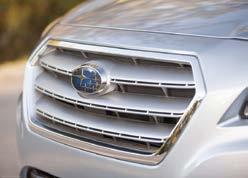
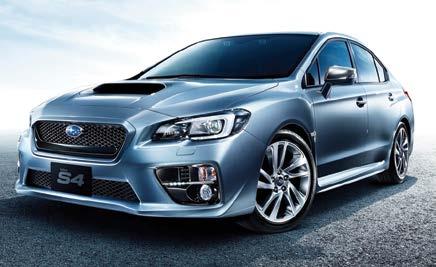
A Ford spokesperson told Teslarati the price increases are in response to current material costs, market factors and supply chain constraints.
The increases mark a substantial hike in F-150 Lightning prices since the truck was first offered. In January 2022, Ford announced that the Pro trim would start at
$39,974, the Lariat at $67,474, and the Platinum at $90,874.
The once-affordable Pro trim of the F-150 Lightning has gone up considerably and is now a full $20,000 more than it was when it was first announced, nearly a 50% increase in price since then.
Ford reopened order banks for the F-150 Lightning on March 30 for prospective owners who already had reservations to buy the pickup. Ford has ramped production to three shifts a the Rouge Electric Vehicle Center in Dearborn, MI.

The REVC is returning to full production as well, and trucks will begin shipping to customers.

The automaker shut down production in February for more than a month as a fire caused by an electrical shortcircuit in the battery pack in the REVC. Ford issued a recall of 18 units that may have contained the potential defect.

Publisher Jeremy Hayhurst
General Manager
Barbara Davies
Editor
Abby Andrews
Contributing Writers
Mike Anderson, Ed Attanasio, Stacey Phillips, Cole Strandberg, John Yoswick
Advertising Sales
Joe Momber, Norman Morano
Office Manager
Kelly Cashman
Digital Marketing Manager

Bryan Malinski
Art Director
Rodolfo Garcia
Senior Designer
Vicki Sitarz
Accounting & HR Manager
Heather Priddy
Permissions Editor
Randi Scholtes
Serving Alaska, California, Hawaii, Idaho, Montana, Nevada, Oregon, Washington and Wyoming. Autobody News is a monthly publication for the autobody industry. Permission to reproduce in any form the material published in Autobody News must be obtained in writing from the publisher.
©2023 Adamantine Media LLC.
Autobody News P.O. Box 1516 Carlsbad, CA 92018 (800) 699-8251 (760) 603-3229 Fax



www.autobodynews.com



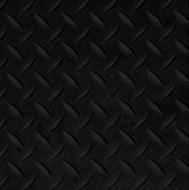
editor@autobodynews.com

Tesla is said to be considering a potential U.S.-based battery plant with one of its suppliers, CATL, according to a March 30 report from Bloomberg, citing people familiar with the matter.
Tesla has not confirmed these reports, and Rohan Patel, the automaker’s senior global director of public policy, did not respond to Teslarati’s request for comment.
The report indicated Tesla discussed the rumored plans with the White House, aiming to gain clarification on rules relating to the Inflation Reduction Act (IRA). The IRA rules can qualify certain EVs for either some or all of the $7,500 tax credit for purchasing a clean energy vehicle.
One of the stipulations is a portion of the battery pack
must be manufactured in the U.S., which is why Tesla and CATL could be looking to launch a partnership within the country.
Ford announced a similar deal with CATL in Feburary, looking to build a battery manufacturing plant within the U.S. to take advantage of these incentives.
According to the report, Tesla is considering Texas, where it moved its headquarters in 2021, and operates the Gigafactory Texas plant just outside of Austin.
It would make sense to build a battery cell facility in the state, as Tesla bolsters a large-scale manufacturing operation plan in Austin.
Tesla is also working to begin construction on its next facility in Nuevo Leon, Mexico, which would make the potential cell plant location ideal for both facilities.
expensive car make to insure, with an annual average cost of $164 per month or $1,964 per year for 2022 models. This is about 13% higher than the national average.
While some car makes are typically more expensive to insure, others are generally cheaper than the national average.
According to Quadrant Information Services, Mazda ranks as the least expensive car to insure. Mazda’s 2022 models have an average annual insurance rate of $138 per month or $1,658 per year for fullcoverage policies, coming in at around 4% less than the national average.
2. Volkswagen
Volkswagen is the second cheapest car make to insure, with 2022 models seeing an average annual rate of $142 per month of $1,707 per year. While this is only about 1% less than the national average, top providers’ average rates for Volkswagen are significantly lower.
On average, car insurance premium costs for 2022 Subaru models are around $146 per month or $1,752 each year. However, it’s relatively easy to compare quotes and get reduced rates on Subaru insurance coverage.
4. Jeep
While it’s the fourth cheapest car brand to insure, the average cost for Jeep insurance still sits at $153 per month or $1,833 per year. Drivers may find significantly different rates for models such as the Wrangler than for the Jeep Grand Cherokee or Compass.
5. Honda
On average, it costs $156 per month or $1,869 each year to insure a 2022 Honda model. While this is higher than the national average, there are many reputable insurance companies that offer cheaper prices for full-coverage auto insurance.
A vehicle’s make and model aren’t the only factors that can change car insurance cost. Providers also consider the following factors when setting premiums:
Location: Car insurance rates vary widely based on where drivers live. Population density, climate and
even the number of claims processed nearby can influence insurance costs.
Age: Younger and less experienced motorists are seen as riskier to insure, so they can expect to pay more for insurance than those with a long driving history.
Credit history: A high credit score is seen as a mark of financial responsibility and reliability, which often equates to lower insurance rates. A poor credit score can result in much more costly insurance premiums.
Driving record: If a driver has a speeding ticket, a recent at-fault accident or a driving under the influence (DUI) charge on their driving record, they’ll get charged more for insurance than someone with a clean record.
Marital status: Those who are married typically pay less for auto insurance than single drivers.
Gender: Men, especially young men, usually pay more for car insurance than women.
Chosen deductible: Drivers can expect to pay higher premiums if they choose a low or nonexistent deductible when filing claims.
Source: Guides Auto Team
During the month of March, CARSTAR honored and spotlighted the leading women in the family.
Jordyn Ciciora, estimator, CARSTAR Danrich in Homer Glen, IL, has been with CARSTAR for two years. Ciciora initially joined as a repair consultant and manned the phones, but soon expressed interest in becoming an estimator. With her own sense of determination and the support of her team, Ciciora soon completed the mandated training and courses.
“Ever since I was young, I have been surrounded by friends and family who were interested in the automotive world,” said Ciciora. “Eventually, I purchased my own 2016 RAM 2500 truck and slowly began making cosmetic and mechanical repairs myself. I enjoyed the challenge of working with complex components and knew this challenge was something I wanted in my career.”
Ciciora is grateful for the opportunities CARSTAR has provided and said the mutual respect in the workplace and common goal of following all OEM guidelines is what keeps her motivated.
Source: CARSTAR
Volkswagen is recalling 143,053 examples of the 2018-2021 Atlas and 2020 Atlas Cross Sport because the front passenger airbag might not deploy in a collision. The automaker advises owners not to ride with anyone in the passenger seat until the repair is complete.
The problem is a potential fault in the wiring for the occupant detection system for the front passenger seat. It might not sense that a person is sitting there, and if that happens, the airbag wouldn’t deploy.
VW doesn’t yet have a repair for this issue, but the company is developing one. The automaker will notify affected owners when the fix is ready.
VW began investigating this issue in August 2019 after receiving reports about the potential problem. It analyzed the situation with suppliers through May 2020. More investigation into the root
cause and possible fixes occurred until January 2021. In February 2021, the Volkswagen Product Safety Committee found the failure of the occupant detection system was “highly sporadic,” according to the automaker’s chronology of the


year. The updated exterior styling includes larger headlights and a light bar stretching across the nose. Similarly, there’s another illuminated strip on the rear for all but the base trim.

Inside, they feature a 12inch infotainment screen and a 10.3-inch digital instrument cluster. Wireless Apple CarPlay and Android Auto are standard. Leatherette covers the dashboard and center console.
issue.
The product safety committee released a technical bulletin about this problem in June 2021. The company kept investigating the problem. On March 22, the automaker decided to recall the affected vehicles.
VW introduced refreshed versions of the Atlas and Atlas Cross Sport for the 2024 model

The Atlas is now only available with a turbocharged 2.0-liter four-cylinder. It makes 269 horsepower and 273 pound-feet of torque. An eight-speed automatic routes the power either to the front wheels or the optional all-wheeldrive system.
The IQ.Drive safety tech suite is now standard. It includes lane centering, lane-keep assist and automatic braking. Adaptive cruise control is an optional upgrade.
Material
MATERIALS
Hundreds of supplier relationships


Industrial Finishes has experts on staff
